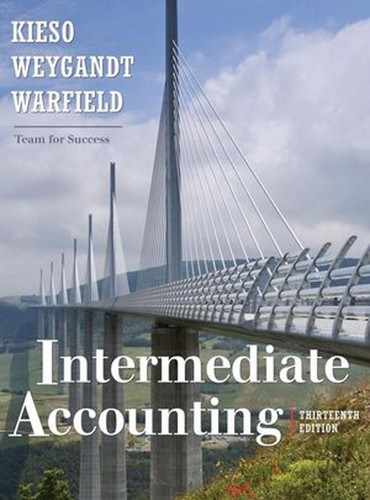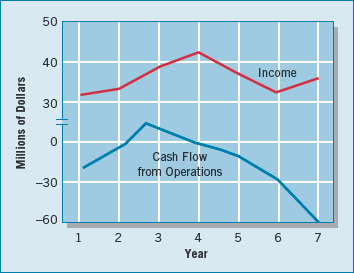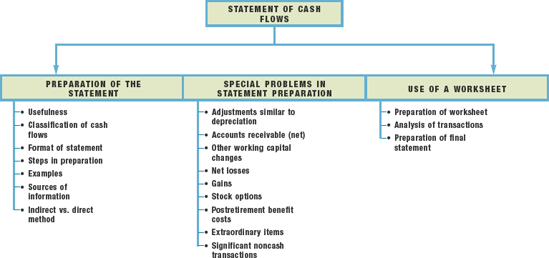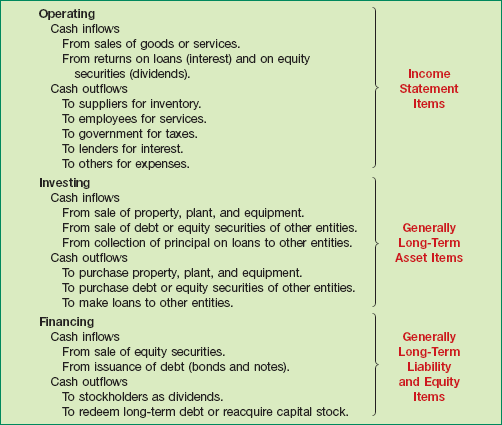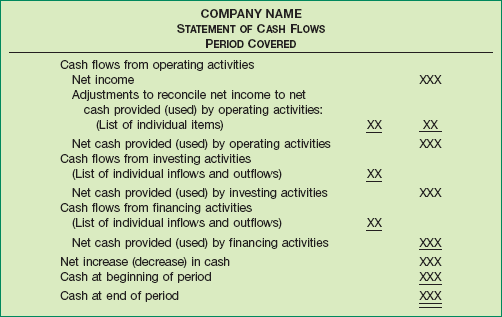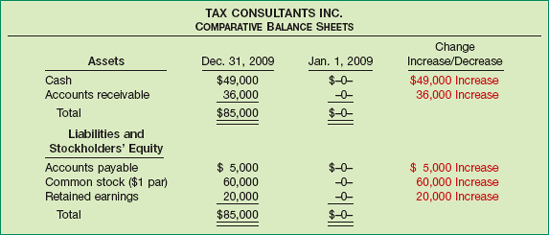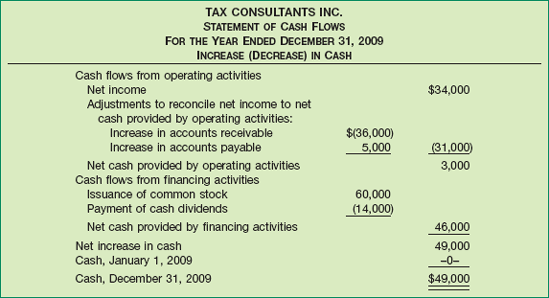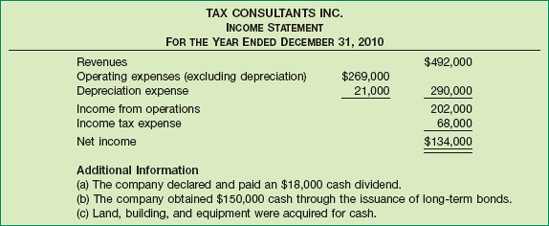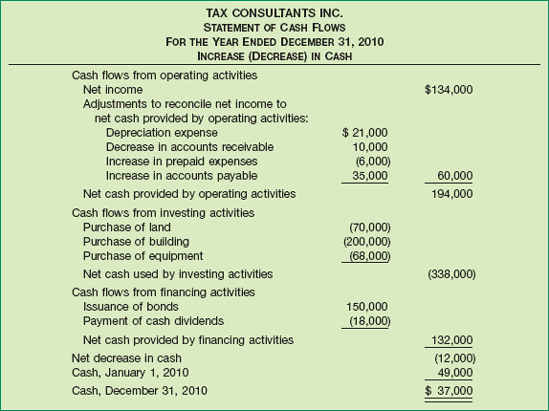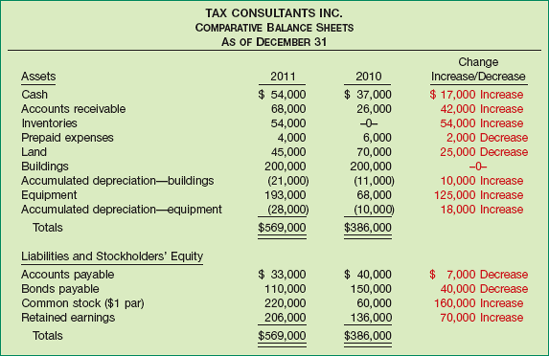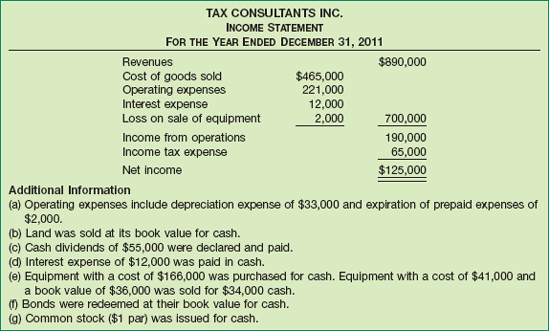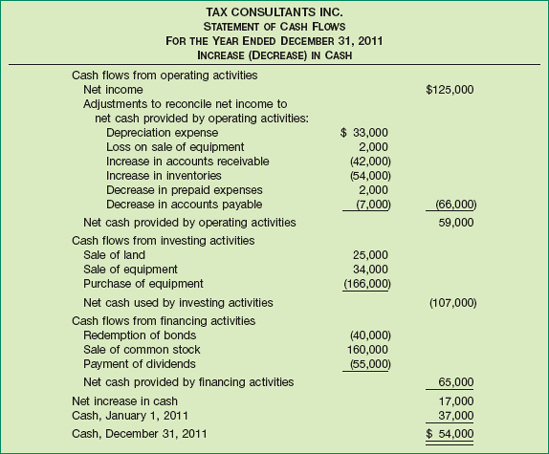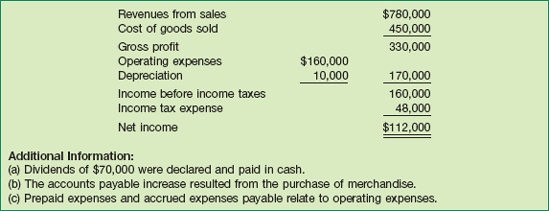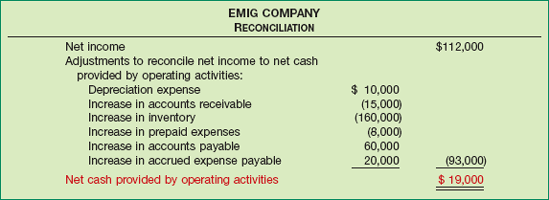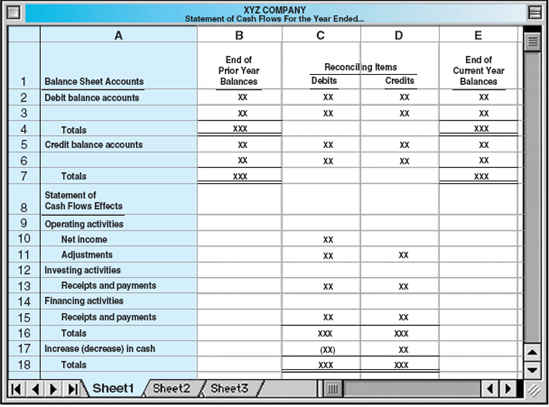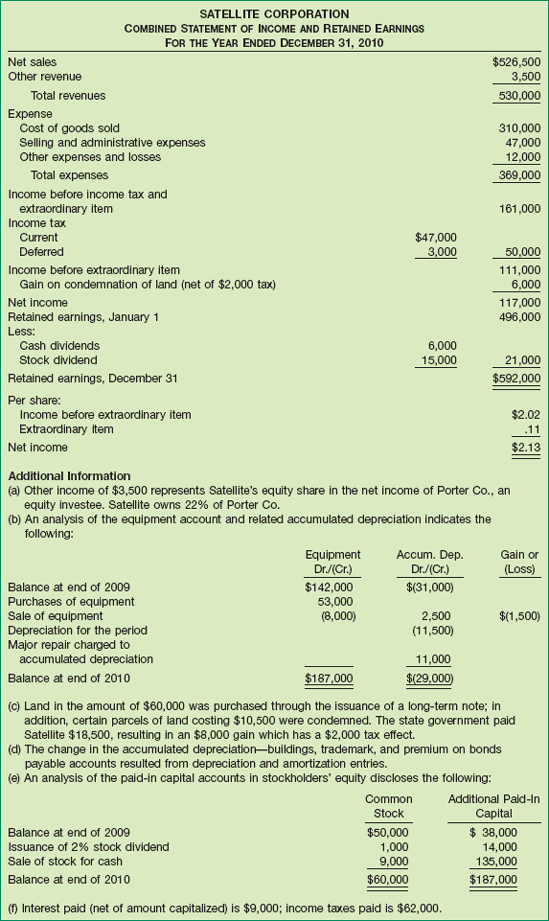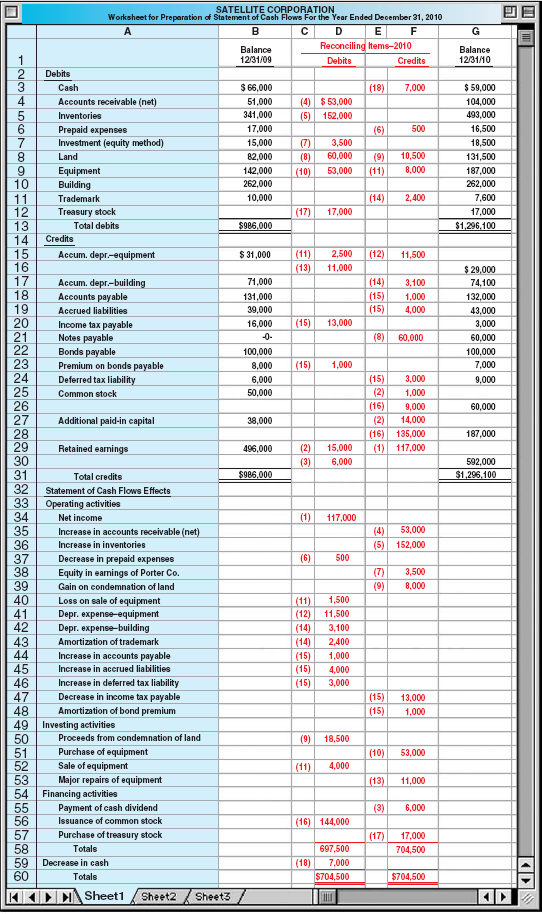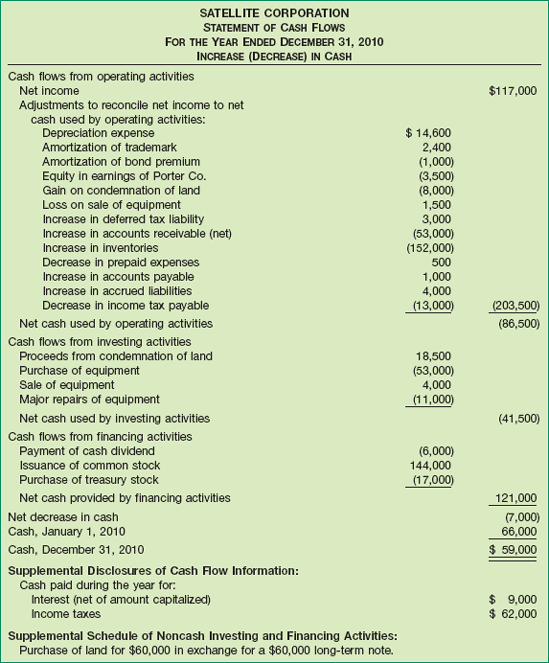LEARNING OBJECTIVES
After studying this chapter, you should be able to:
The primary purpose of the statement of cash flows is to provide information about a company's cash receipts and cash payments during a period. A secondary objective is to provide cash-basis information about the company's operating, investing, and financing activities. The statement of cash flows therefore reports cash receipts, cash payments, and net change in cash resulting from a company's operating, investing, and financing activities during a period. Its format reconciles the beginning and ending cash balances for the period.
The statement of cash flows provides information to help investors, creditors, and others assess the following [1]:
The entity's ability to generate future cash flows. A primary objective of financial reporting is to provide information with which to predict the amounts, timing, and uncertainty of future cash flows. By examining relationships between items such as sales and net cash flow from operating activities, or net cash flow from operating activities and increases or decreases in cash, it is possible to better predict the future cash flows than is possible using accrual-basis data alone.
The entity's ability to pay dividends and meet obligations. Simply put, cash is essential. Without adequate cash, a company cannot pay employees, settle debts, pay out dividends, or acquire equipment. A statement of cash flows indicates where the company's cash comes from and how the company uses its cash. Employees, creditors, stockholders, and customers should be particularly interested in this statement, because it alone shows the flows of cash in a business.
The reasons for the difference between net income and net cash flow from operating activities. The net income number is important: It provides information on the performance of a company from one period to another. But some people are critical of accrual-basis net income because companies must make estimates to arrive at it. Such is not the case with cash. Thus, as the opening story showed, financial statement readers can benefit from knowing why a company's net income and net cash flow from operating activities differ, and can assess for themselves the reliability of the income number.
The cash and noncash investing and financing transactions during the period. Besides operating activities, companies undertake investing and financing transactions. Investing activities include the purchase and sale of assets other than a company's products or services. Financing activities include borrowings and repayments of borrowings, investments by owners, and distributions to owners. By examining a company's investing and financing activities, a financial statement reader can better understand why assets and liabilities increased or decreased during the period. For example, by reading the statement of cash flows, the reader might find answers to following questions:
Why did cash decrease for Toys R Us when it reported net income for the period?
How much did Southwest Airlines spend on property, plant, and equipment last year?
Did dividends paid by Campbell's Soup increase?
How much money did Coca-Cola borrow last year?
How much cash did Hewlett-Packard use to repurchase its common stock?
The statement of cash flows classifies cash receipts and cash payments by operating, investing, and financing activities.[415] Transactions and other events characteristic of each kind of activity is as follows.
Operating activities involve the cash effects of transactions that enter into the determination of net income, such as cash receipts from sales of goods and services, and cash payments to suppliers and employees for acquisitions of inventory and expenses.
Investing activities generally involve long-term assets and include (a) making and collecting loans, and (b) acquiring and disposing of investments and productive long-lived assets.
Financing activities involve liability and stockholders' equity items and include (a) obtaining cash from creditors and repaying the amounts borrowed, and (b) obtaining capital from owners and providing them with a return on, and a return of, their investment.
Illustration 23-1 classifies the typical cash receipts and payments of a company according to operating, investing, and financing activities. The operating activities category is the most important. It shows the cash provided by company operations. This source of cash is generally considered to be the best measure of a company's ability to generate enough cash to continue as a going concern.
Note the following general guidelines about the classification of cash flows.
Companies classify some cash flows relating to investing or financing activities as operating activities.[416] For example, companies classify receipts of investment income (interest and dividends) and payments of interest to lenders as operating activities. Why are these considered operating activities? Companies report these items in the income statement, where the results of operations are shown.
Conversely, companies classify some cash flows relating to operating activities as investing or financing activities. For example, a company classifies the cash received from the sale of property, plant, and equipment at a gain, although reported in the income statement, as an investing activity. It excludes the effects of the related gain in net cash flow from operating activities. Likewise, a gain or loss on the payment (extinguishment) of debt is generally part of the cash outflow related to the repayment of the amount borrowed. It therefore is a financing activity.
To evaluate overall cash flow, it is useful to understand where in the product life cycle a company is. Generally, companies move through several stages of development, which have implications for cash flow. As the graph below shows, the pattern of cash flows from operating, financing, and investing activities will vary depending on the stage of the product life cycle.
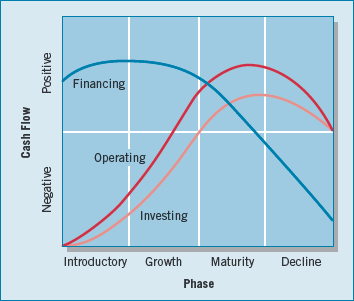
In the introductory phase, the product is likely not generating much revenue (operating cash flow is negative). Because the company is making heavy investments to get a product off the ground, cash flow from investment is negative, and financing cash flows are positive.
As the product moves to the growth and maturity phases, these cash flow relationships reverse. The product generates more cash flow from operations, which can be used to cover investments needed to support the product, and less cash is needed from financing. So is a negative operating cash flow bad? Not always. It depends on the product life cycle.
Source: Adapted from Paul D. Kimmel, Jerry J. Weygandt, and Donald E. Kieso, Financial Accounting: Tools for Business Decision Making, 5th ed. (New York: John Wiley & Sons, 2009), p. 606.
The three activities we discussed above constitute the general format of the statement of cash flows. The operating activities section always appears first. It is followed by the investing activities section and then the financing activities section.
A company reports the individual inflows and outflows from investing and financing activities separately. That is, a company reports them gross, not netted against one another. Thus, a cash outflow from the purchase of property is reported separately from the cash inflow from the sale of property. Similarly, a cash inflow from the issuance of debt is reported separately from the cash outflow from its retirement.
The net increase or decrease in cash reported during the period should reconcile the beginning and ending cash balances as reported in the comparative balance sheets. The general format of the statement of cash flows presents the results of the three activities discussed previously–operating, investing, and financing. Illustration 23-2 shows a widely used form of the statement of cash flows.
Companies prepare the statement of cash flows differently from the three other basic financial statements. For one thing, it is not prepared from an adjusted trial balance. The cash flow statement requires detailed information concerning the changes in account balances that occurred between two points in time. An adjusted trial balance will not provide the necessary data. Second, the statement of cash flows deals with cash receipts and payments. As a result, the company must adjust the effects of the use of accrual accounting to determine cash flows. The information to prepare this statement usually comes from three sources:
Comparative balance sheets provide the amount of the changes in assets, liabilities, and equities from the beginning to the end of the period.
Current income statement data help determine the amount of cash provided by or used by operations during the period.
Selected transaction data from the general ledger provide additional detailed information needed to determine how the company provided or used cash during the period.
Preparing the statement of cash flows from the data sources above involves three major steps:
Step 1. Determine the change in cash. This procedure is straightforward. A company can easily compute the difference between the beginning and the ending cash balance from examining its comparative balance sheets.
Step 2. Determine the net cash flow from operating activities. This procedure is complex. It involves analyzing not only the current year's income statement but also comparative balance sheets as well as selected transaction data.
Step 3. Determine net cash flows from investing and financing activities. A company must analyze all other changes in the balance sheet accounts to determine their effects on cash.
On the following pages we work through these three steps in the process of preparing the statement of cash flows for Tax Consultants Inc. over several years.
To illustrate a statement of cash flows, we use the first year of operations for Tax Consultants Inc. The company started on January 1, 2009, when it issued 60,000 shares of $1 par value common stock for $60,000 cash. The company rented its office space, furniture, and equipment, and performed tax consulting services throughout the first year. The comparative balance sheets at the beginning and end of the year 2009 appear in Illustration 23-3.
Illustration 23-4 (on page 1249) shows the income statement and additional information for Tax Consultants.
To prepare a statement of cash flows, the first step is to determine the change in cash. This is a simple computation. Tax Consultants had no cash on hand at the beginning of the year 2009. It had $49,000 on hand at the end of 2009. Thus, cash changed (increased) in 2009 by $49,000.
To determine net cash flow from operating activities,[417] companies adjust net income in numerous ways. A useful starting point is to understand why net income must be converted to net cash provided by operating activities.
Under generally accepted accounting principles, most companies use the accrual basis of accounting. As you have learned, this basis requires that companies record revenue when earned and record expenses when incurred. Earned revenues may include credit sales for which the company has not yet collected cash. Expenses incurred may include some items that the company has not yet paid in cash. Thus, under the accrual basis of accounting, net income is not the same as net cash flow from operating activities.
To arrive at net cash flow from operating activities, a company must determine revenues and expenses on a cash basis. It does this by eliminating the effects of income statement transactions that do not result in an increase or decrease in cash. Illustration 23-5 shows the relationship between net income and net cash flow from operating activities.
In this chapter, we use the term net income to refer to accrual-based net income. A company may convert net income to net cash flow from operating activities through either a direct method or an indirect method. We explain both methods in the following sections. The advantages and disadvantages of these two methods are discussed later in the chapter.
The direct method (also called the income statement method) reports cash receipts and cash disbursements from operating activities. The difference between these two amounts is the net cash flow from operating activities. In other words, the direct method deducts operating cash disbursements from operating cash receipts. The direct method results in the presentation of a condensed cash receipts and cash disbursements statement.
As indicated from the accrual-based income statement, Tax Consultants reported revenues of $125,000. However, because the company's accounts receivable increased during 2009 by $36,000, the company collected only $89,000 ($125,000 − $36,000) in cash from these revenues. Similarly, Tax Consultants reported operating expenses of $85,000. However, accounts payable increased during the period by $5,000. Assuming that these payables relate to operating expenses, cash operating expenses were $80,000 ($85,000 − $5,000). Because no taxes payable exist at the end of the year, the company must have paid $6,000 income tax expense for 2009 in cash during the year. Tax Consultants computes net cash flow from operating activities as shown in Illustration 23-6.
"Net cash provided by operating activities" is the equivalent of cash basis net income. ("Net cash used by operating activities" is equivalent to cash basis net loss.)
The indirect method (or reconciliation method) starts with net income and converts it to net cash flow from operating activities. In other words, the indirect method adjusts net income for items that affected reported net income but did not affect cash. To compute net cash flow from operating activities, a company adds back noncash charges in the income statement to net income and deducts noncash credits. We explain the two adjustments to net income for Tax Consultants, namely, the increases in accounts receivable and accounts payable, as follows.
Increase in Accounts Receivable—Indirect Method. Tax Consultant's accounts receivable increased by $36,000 (from $0 to $36,000) during the year. For Tax Consultants, this means that cash receipts were $36,000 lower than revenues. The Accounts Receivable account in Illustration 23-7 shows that Tax Consultants had $125,000 in revenues (as reported on the income statement), but it collected only $89,000 in cash.
As shown in Illustration 23-8, to adjust net income to net cash provided by operating activities, Tax Consultants must deduct the increase of $36,000 in accounts receivable from net income. When the Accounts Receivable balance decreases, cash receipts are higher than revenue earned under the accrual basis. Therefore, the company adds to net income the amount of the decrease in accounts receivable to arrive at net cash provided by operating activities.
Increase in Accounts Payable—Indirect Method. When accounts payable increase during the year, expenses on an accrual basis exceed those on a cash basis. Why? Because Tax Consultants incurred expenses, but some of the expenses are not yet paid. To convert net income to net cash flow from operating activities, Tax Consultants must add back the increase of $5,000 in accounts payable to net income.
As a result of the accounts receivable and accounts payable adjustments, Tax Consultants determines net cash provided by operating activities is $3,000 for the year 2009. Illustration 23-8 shows this computation.
Note that net cash provided by operating activities is the same whether using the direct (Illustration 23-6) or the indirect method (Illustration 23-8).
Due to recent concerns about a decline in the quality of earnings, some investors have been focusing on cash flow. Management has an incentive to make operating cash flow look good because Wall Street has paid a premium for companies that generate a lot of cash from operations, rather than through borrowings. However, similar to earnings, companies have ways to pump up cash flow from operations.
One way that companies can boost their operating cash flow is by "securitizing" receivables. That is, companies can speed up cash collections by selling their receivables. For example, Federated Department Stores reported a $2.2 billion increase in cash flow from operations. This seems impressive until you read the fine print, which indicates that a big part of the increase was due to the sale of receivables. As discussed in this section, decreases in accounts receivable increase cash flow from operations. So while it appeared that Federated's core operations had improved, the company really did little more than accelerate collections of its receivables. In fact, the cash flow from the securitizations represented more than half of Federated's operating cash flow. Thus, just like earnings, cash flow can be of high or low quality.
Source: Adapted from Ann Tergesen, "Cash Flow Hocus Pocus," Business Week (July 16, 2002), pp. 130–131. See also Bear Stearns Equity Research, Accounting Issues: Cash Flow Metrics (June 2006).
After Tax Consultants has computed the net cash provided by operating activities, the next step is to determine whether any other changes in balance sheet accounts caused an increase or decrease in cash.
For example, an examination of the remaining balance sheet accounts for Tax Consultants shows increases in both common stock and retained earnings. The common stock increase of $60,000 resulted from the issuance of common stock for cash. The issuance of common stock is reported in the statement of cash flows as a receipt of cash from a financing activity.
Two items caused the retained earnings increase of $20,000:
Net income of $34,000 increased retained earnings.
Declaration of $14,000 of dividends decreased retained earnings.
Tax Consultants has converted net income into net cash flow from operating activities, as explained earlier. The additional data indicate that it paid the dividend. Thus, the company reports the dividend payment as a cash outflow, classified as a financing activity.
We are now ready to prepare the statement of cash flows. The statement starts with the operating activities section. Tax Consultants may use either the direct or indirect method to report net cash flow from operating activities.
The FASB encourages the use of the direct method over the indirect method. If a company uses the direct method of reporting net cash flow from operating activities, the FASB requires that the company provide in a separate schedule a reconciliation of net income to net cash flow from operating activities. If a company uses the indirect method, it can either report the reconciliation within the statement of cash flows or can provide it in a separate schedule, with the statement of cash flows reporting only the net cash flow from operating activities. [3] Throughout this chapter we use the indirect method, which is also used more extensively in practice.[418] In doing homework assignments, you should follow instructions for use of either the direct or indirect method.
Illustration 23-9 shows the statement of cash flows for Tax Consultants Inc., for year 1 (2009).
As indicated, the $60,000 increase in common stock results in a financing-activity cash inflow. The payment of $14,000 in cash dividends is a financing-activity outflow of cash. The $49,000 increase in cash reported in the statement of cash flows agrees with the increase of $49,000 shown in the comparative balance sheets as the change in the cash account.
Tax Consultants Inc. continued to grow and prosper in its second year of operations. The company purchased land, building, and equipment, and revenues and net income increased substantially over the first year. Illustrations 23-10 and 23-11 present information related to the second year of operations for Tax Consultants Inc.
To prepare a statement of cash flows from the available information, the first step is to determine the change in cash. As indicated from the information presented, cash decreased $12,000 ($49,000 − $37,000).
Using the indirect method, we adjust net income of $134,000 on an accrual basis to arrive at net cash flow from operating activities. Explanations for the adjustments to net income follow.
Decrease in Accounts Receivable. Accounts receivable decreased during the period, because cash receipts (cash-basis revenues) are higher than revenues reported on an accrual basis. To convert net income to net cash flow from operating activities, the decrease of $10,000 in accounts receivable must be added to net income.
Increase in Prepaid Expenses. When prepaid expenses (assets) increase during a period, expenses on an accrual-basis income statement are lower than they are on a cash-basis income statement. The reason: Tax Consultants has made cash payments in the current period, but expenses (as charges to the income statement) have been deferred to future periods. To convert net income to net cash flow from operating activities, the company must deduct from net income the increase of $6,000 in prepaid expenses. An increase in prepaid expenses results in a decrease in cash during the period.
Increase in Accounts Payable. Like the increase in 2009, Tax Consultants must add the 2010 increase of $35,000 in accounts payable to net income, to convert to net cash flow from operating activities. The company incurred a greater amount of expense than the amount of cash it disbursed.
Depreciation Expense (Increase in Accumulated Depreciation). The purchase of depreciable assets is a use of cash, shown in the investing section in the year of acquisition. Tax Consultant's depreciation expense of $21,000 (also represented by the increase in accumulated depreciation) is a noncash charge; the company adds it back to net income, to arrive at net cash flow from operating activities. The $21,000 is the sum of the $11,000 depreciation on the building plus the $10,000 depreciation on the equipment.
Certain other periodic charges to expense do not require the use of cash. Examples are the amortization of intangible assets and depletion expense. Such charges are treated in the same manner as depreciation. Companies frequently list depreciation and similar noncash charges as the first adjustments to net income in the statement of cash flows.
As a result of the foregoing items, net cash provided by operating activities is $194,000 as shown in Illustration 23-12.
After you have determined the items affecting net cash provided by operating activities, the next step involves analyzing the remaining changes in balance sheet accounts. Tax Consultants Inc. analyzed the following accounts.
Increase in Land. As indicated from the change in the land account, the company purchased land of $70,000 during the period. This transaction is an investing activity, reported as a use of cash.
Increase in Building and Related Accumulated Depreciation. As indicated in the additional data, and from the change in the building account, Tax Consultants acquired an office building using $200,000 cash. This transaction is a cash outflow, reported in the investing section. The $11,000 increase in accumulated depreciation results from recording depreciation expense on the building. As indicated earlier, the reported depreciation expense has no effect on the amount of cash.
Increase in Equipment and Related Accumulated Depreciation. An increase in equipment of $68,000 resulted because the company used cash to purchase equipment. This transaction is an outflow of cash from an investing activity. The depreciation expense entry for the period explains the increase in Accumulated Depreciation—Equipment.
Increase in Bonds Payable. The bonds payable account increased $150,000. Cash received from the issuance of these bonds represents an inflow of cash from a financing activity.
Increase in Retained Earnings. Retained earnings increased $116,000 during the year. Two factors explain this increase: (1) Net income of $134,000 increased retained earnings, and (2) dividends of $18,000 decreased retained earnings. As indicated earlier, the company adjusts net income to net cash provided by operating activities in the operating activities section. Payment of the dividends is a financing activity that involves a cash outflow.
Our third example, covering the 2011 operations of Tax Consultants Inc., is more complex. It again uses the indirect method to compute and present net cash flow from operating activities.
Tax Consultants Inc. experienced continued success in 2011 and expanded its operations to include the sale of computer software used in tax-return preparation and tax planning. Thus, inventory is a new asset appearing in the company's December 31, 2011, balance sheet. Illustrations 23-14 and 23-15 (on page 1256) show the comparative balance sheets, income statements, and selected data for 2011.
The first step in the preparation of the statement of cash flows is to determine the change in cash. As the comparative balance sheets show, cash increased $17,000 in 2011.
We explain the adjustments to net income of $125,000 as follows.
Increase in Accounts Receivable. The increase in accounts receivable of $42,000 represents recorded accrual-basis revenues in excess of cash collections in 2011. The company deducts this increase from net income to convert from the accrual basis to the cash basis.
Increase in Inventories. The $54,000 increase in inventories represents an operating use of cash, not an expense. Tax Consultants therefore deducts this amount from net income, to arrive at net cash flow from operations. In other words, when inventory purchased exceeds inventory sold during a period, cost of goods sold on an accrual basis is lower than on a cash basis.
Decrease in Prepaid Expenses. The $2,000 decrease in prepaid expenses represents a charge to the income statement for which Tax Consultants made no cash payment in the current period. The company adds back the decrease to net income, to arrive at net cash flow from operating activities.
Decrease in Accounts Payable. When accounts payable decrease during the year, cost of goods sold and expenses on a cash basis are higher than they are on an accrual basis. To convert net income to net cash flow from operating activities, the company must deduct the $7,000 in accounts payable from net income.
Depreciation Expense (Increase in Accumulated Depreciation). Accumulated Depreciation—Buildings increased $10,000 ($21,000 − $11,000). The Buildings account did not change during the period, which means that Tax Consultants recorded depreciation expense of $10,000 in 2011.
Accumulated Depreciation—Equipment increased by $18,000 ($28,000 − $10,000) during the year. But Accumulated Depreciation—Equipment decreased by $5,000 as a result of the sale during the year. Thus, depreciation for the year was $23,000. The company reconciled Accumulated Depreciation—Equipment as follows.

The company must add back to net income the total depreciation of $33,000 ($10,000 + $23,000) charged to the income statement, to determine net cash flow from operating activities.
Loss on Sale of Equipment. Tax Consultants Inc. sold for $34,000 equipment that cost $41,000 and had a book value of $36,000. As a result, the company reported a loss of $2,000 on its sale. To arrive at net cash flow from operating activities, it must add back to net income the loss on the sale of the equipment. The reason is that the loss is a noncash charge to the income statement. The loss did not reduce cash, but it did reduce net income.[419]
From the foregoing items, the company prepares the operating activities section of the statement of cash flows, as shown in Illustration 23-16.
By analyzing the remaining changes in the balance sheet accounts, Tax Consultants identifies cash flows from investing and financing activities.
Land. Land decreased $25,000 during the period. As indicated from the information presented, the company sold land for cash at its book value. This transaction is an investing activity, reported as a $25,000 source of cash.
Equipment. An analysis of the equipment account indicates the following.

The company used cash to purchase equipment with a fair value of $166,000—an investing transaction reported as a cash outflow. The sale of the equipment for $34,000 is also an investing activity, but one that generates a cash inflow.
Bonds Payable. Bonds payable decreased $40,000 during the year. As indicated from the additional information, the company redeemed the bonds at their book value. This financing transaction used $40,000 of cash.
Common Stock. The common stock account increased $160,000 during the year. As indicated from the additional information, Tax Consultants issued common stock of $160,000 at par. This financing transaction provided cash of $160,000.
Retained Earnings. Retained earnings changed $70,000 ($206,000 − $136,000) during the year. The $70,000 change in retained earnings results from net income of $125,000 from operations and the financing activity of paying cash dividends of $55,000.
Tax Consultants Inc. combines the foregoing items to prepare the statement of cash flows shown in Illustration 23-17.
Important points to remember in the preparation of the statement of cash flows are these:
Comparative balance sheets provide the basic information from which to prepare the report. Additional information obtained from analyses of specific accounts is also included.
An analysis of the Retained Earnings account is necessary. The net increase or decrease in Retained Earnings without any explanation is a meaningless amount in the statement. Without explanation, it might represent the effect of net income, dividends declared, or prior period adjustments.
The statement includes all changes that have passed through cash or have resulted in an increase or decrease in cash.
Write-downs, amortization charges, and similar "book" entries, such as depreciation of plant assets, represent neither inflows nor outflows of cash, because they have no effect on cash. To the extent that they have entered into the determination of net income, however, the company must add them back to or subtract them from net income, to arrive at net cash provided (used) by operating activities.
As we discussed previously, the two different methods available to adjust income from operations on an accrual basis to net cash flow from operating activities are the indirect (reconciliation) method and the direct (income statement) method.
The FASB encourages use of the direct method and permits use of the indirect method. Yet, if the direct method is used, the Board requires that companies provide in a separate schedule a reconciliation of net income to net cash flow from operating activities. Therefore, under either method, companies must prepare and report information from the indirect (reconciliation) method.
For consistency and comparability and because it is the most widely used method in practice, we used the indirect method in the examples just presented. We determined net cash flows from operating activities by adding back to or deducting from net income those items that had no effect on cash. Illustration 23-18 presents more completely the common types of adjustments that companies make to net income to arrive at net cash flow from operating activities.
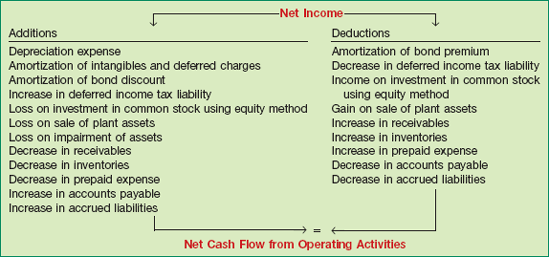
Figure 23-18. Adjustments Needed to Determine Net Cash Flow from Operating Activities—Indirect Method
The additions and deductions in Illustration 23-18 reconcile net income to net cash flow from operating activities, illustrating why the indirect method is also called the reconciliation method.
Under the direct method the statement of cash flows reports net cash flow from operating activities as major classes of operating cash receipts (e.g., cash collected from customers and cash received from interest and dividends) and cash disbursements (e.g., cash paid to suppliers for goods, to employees for services, to creditors for interest, and to government authorities for taxes).
We illustrate the direct method here in more detail to help you understand the difference between accrual-based income and net cash flow from operating activities. This example also illustrates the data needed to apply the direct method. Emig Company, which began business on January 1, 2010, has the following selected balance sheet information.
Emig Company's December 31, 2010, income statement and additional information are as follows.
Under the direct method, companies compute net cash provided by operating activities by adjusting each item in the income statement from the accrual basis to the cash basis. To simplify and condense the operating activities section, only major classes of operating cash receipts and cash payments are reported. As Illustration 23-21 shows, the difference between these major classes of cash receipts and cash payments is the net cash provided by operating activities.
An efficient way to apply the direct method is to analyze the revenues and expenses reported in the income statement in the order in which they are listed. The company then determines cash receipts and cash payments related to these revenues and expenses. In the following sections, we present the direct method adjustments for Emig Company in 2010, to determine net cash provided by operating activities.
Cash Receipts from Customers. The income statement for Emig Company reported revenues from customers of $780,000. To determine cash receipts from customers, the company considers the change in accounts receivable during the year.
When accounts receivable increase during the year, revenues on an accrual basis are higher than cash receipts from customers. In other words, operations led to increased revenues, but not all of these revenues resulted in cash receipts. To determine the amount of increase in cash receipts, deduct the amount of the increase in accounts receivable from the total sales revenues. Conversely, a decrease in accounts receivable is added to sales revenues, because cash receipts from customers then exceed sales revenues.
For Emig Company, accounts receivable increased $15,000. Thus, cash receipts from customers were $765,000, computed as follows.

Emig could also determine cash receipts from customers by analyzing the Accounts Receivable account as shown below.

Illustration 23-22 shows the relationships between cash receipts from customers, revenues from sales, and changes in accounts receivable.
Cash Payments to Suppliers. Emig Company reported cost of goods sold on its income statement of $450,000. To determine cash payments to suppliers, the company first finds purchases for the year, by adjusting cost of goods sold for the change in inventory. When inventory increases during the year, purchases this year exceed cost of goods sold. As a result, the company adds the increase in inventory to cost of goods sold, to arrive at purchases.
In 2010, Emig Company's inventory increased $160,000. The company computes purchases as follows.

After computing purchases, Emig determines cash payments to suppliers by adjusting purchases for the change in accounts payable. When accounts payable increase during the year, purchases on an accrual basis are higher than they are on a cash basis. As a result, it deducts from purchases the increase in accounts payable to arrive at cash payments to suppliers. Conversely, if cash payments to suppliers exceed purchases, Emig adds to purchases the decrease in accounts payable. Cash payments to suppliers were $550,000, computed as follows.

Emig also can determine cash payments to suppliers by analyzing Accounts Payable, as shown below.

Illustration 23-23 shows the relationships between cash payments to suppliers, cost of goods sold, changes in inventory, and changes in accounts payable.
Cash Payments for Operating Expenses. Emig reported operating expenses of $160,000 on its income statement. To determine the cash paid for operating expenses, it must adjust this amount for any changes in prepaid expenses and accrued expenses payable.
For example, when prepaid expenses increased $8,000 during the year, cash paid for operating expenses was $8,000 higher than operating expenses reported on the income statement. To convert operating expenses to cash payments for operating expenses, the company adds to operating expenses the increase of $8,000. Conversely, if prepaid expenses decrease during the year, it deducts from operating expenses the amount of the decrease.
Emig also must adjust operating expenses for changes in accrued expenses payable. When accrued expenses payable increase during the year, operating expenses on an accrual basis are higher than they are on a cash basis. As a result, the company deducts from operating expenses an increase in accrued expenses payable, to arrive at cash payments for operating expenses. Conversely, it adds to operating expenses a decrease in accrued expenses payable, because cash payments exceed operating expenses.
Emig Company's cash payments for operating expenses were $148,000, computed as follows.

The relationships among cash payments for operating expenses, changes in prepaid expenses, and changes in accrued expenses payable are shown in Illustration 23-24.
Note that the company did not consider depreciation expense, because it is a non-cash charge.
Cash Payments for Income Taxes. The income statement for Emig shows income tax expense of $48,000. This amount equals the cash paid. How do we know that? Because the comparative balance sheet indicated no income taxes payable at either the beginning or end of the year.
The following schedule summarizes the computations illustrated above.
Illustration 23-26 shows the presentation of the direct method for reporting net cash flow from operating activities for the Emig Company illustration.
If Emig Company uses the direct method to present the net cash flows from operating activities, it must provide in a separate schedule the reconciliation of net income to net cash provided by operating activities. The reconciliation assumes the identical form and content of the indirect method of presentation, as shown below.
When the direct method is used, the company may present this reconciliation at the bottom of the statement of cash flows or in a separate schedule.
The most contentious decision that the FASB faced related to cash flow reporting was choosing between the direct method and the indirect method of determining net cash flow from operating activities. Companies lobbied against the direct method, urging adoption of the indirect method. Commercial lending officers expressed to the FASB a strong preference in favor of the direct method. In the next two sections, we consider the arguments in favor of each of the methods.
The principal advantage of the direct method is that it shows operating cash receipts and payments. Thus, it is more consistent with the objective of a statement of cash flows—to provide information about cash receipts and cash payments—than the indirect method, which does not report operating cash receipts and payments.
Supporters of the direct method contend that knowledge of the specific sources of operating cash receipts and the purposes for which operating cash payments were made in past periods is useful in estimating future operating cash flows. Furthermore, information about amounts of major classes of operating cash receipts and payments is more useful than information only about their arithmetic sum (the net cash flow from operating activities). Such information is more revealing of a company's ability (1) to generate sufficient cash from operating activities to pay its debts, (2) to reinvest in its operations, and (3) to make distributions to its owners. [4]
Many companies indicate that they do not currently collect information in a manner that allows them to determine amounts such as cash received from customers or cash paid to suppliers directly from their accounting systems. But supporters of the direct method contend that the incremental cost of determining operating cash receipts and payments is not significant.
The principal advantage of the indirect method is that it focuses on the differences between net income and net cash flow from operating activities. That is, it provides a useful link between the statement of cash flows and the income statement and balance sheet.
Many companies contend that it is less costly to adjust net income to net cash flow from operating activities (indirect) than it is to report gross operating cash receipts and payments (direct). Supporters of the indirect method also state that the direct method, which effectively reports income statement information on a cash rather than an accrual basis, may erroneously suggest that net cash flow from operating activities is as good as, or better than, net income as a measure of performance.
Companies that use the direct method are required, at a minimum, to report separately the following classes of operating cash receipts and payments:
Receipts
Cash collected from customers (including lessees, licensees, etc.).
Interest and dividends received.
Other operating cash receipts, if any.
Payments
Cash paid to employees and suppliers of goods or services (including suppliers of insurance, advertising, etc.).
Interest paid.
Income taxes paid.
Other operating cash payments, if any.
The FASB encourages companies to provide further breakdowns of operating cash receipts and payments that they consider meaningful.
Companies using the indirect method must disclose separately changes in inventory, receivables, and payables in order to reconcile net income to net cash flow from operating activities. In addition, they must disclose, elsewhere in the financial statements or in accompanying notes, interest paid (net of amount capitalized) and income taxes paid.[420] The FASB requires these separate and additional disclosures so that users may approximate the direct method. Also, an acceptable alternative presentation of the indirect method is to report net cash flow from operating activities as a single line item in the statement of cash flows and to present the reconciliation details elsewhere in the financial statements.
The controversy over direct and indirect methods highlights the importance that the market attributes to operating cash flow. By showing an improving cash flow, a company can give a favorable impression of its ongoing operations. For example, WorldCom concealed declines in its operations by capitalizing certain operating expenses—to the tune of $3.8 billion! This practice not only "juiced up" income but also made it possible to report the cash payments in the investing section of the cash flow statement rather than as a deduction from operating cash flow.
The SEC recently addressed a similar cash flow classification issue with automakers like Ford, GM, and Chrysler. For years, automakers classified lease receivables and other dealer-financing arrangements as investment cash flows. Thus, they reported an increase in lease or loan receivables from cars sold as a use of cash in the investing section of the statement of cash flows. The SEC objected and now requires automakers to report these receivables as operating cash flows, since the leases and loans are used to facilitate car sales. At GM, these reclassifications reduced its operating cash flows from $7.6 billion to $3 billion in the year before the change. So while the overall cash flow—from operations, investing, and financing—remained the same, operating cash flow at these companies looked better than it really was.
Source: Peter Elstrom, "How to Hide $3.8 Billion in Expenses," BusinessWeek Online (July 8, 2002); and Judith Burns, "SEC Tells US Automakers to Retool Cash-Flow Accounting," Wall Street Journal Online (February 28, 2005).
We discussed some of the special problems related to preparing the statement of cash flows in connection with the preceding illustrations. Other problems that arise with some frequency in the preparation of this statement include the following.
Adjustments similar to depreciation.
Accounts receivable (net).
Other working capital changes.
Net losses.
Gains.
Stock options.
Postretirement benefit cost.
Extraordinary items.
Significant noncash transactions.
Depreciation expense is the most common adjustment to net income that companies make to arrive at net cash flow from operating activities. But there are numerous other noncash expense or revenue items. Examples of expense items that companies must add back to net income are the amortization of limited-life intangible assets such as patents, and the amortization of deferred costs such as bond issue costs. These charges to expense involve expenditures made in prior periods that a company amortizes currently. These charges reduce net income without affecting cash in the current period.
Also, amortization of bond discount or premium on long-term bonds payable affects the amount of interest expense. However, neither changes cash. As a result, a company should add back discount amortization and subtract premium amortization from net income to arrive at net cash flow from operating activities.
In a similar manner, changes in deferred income taxes affect net income but have no effect on cash. For example, Delta Airlines reported an increase in its liability for deferred taxes of approximately $1.2 billion. This change in the liability increased tax expense and decreased net income, but did not affect cash. Therefore, Delta added back $1.2 billion to net income on its statement of cash flows.
Another common adjustment to net income is a change related to an investment in common stock when recording income or loss under the equity method. Recall that under the equity method, the investor (1) debits the investment account and credits revenue for its share of the investee's net income, and (2) credits dividends received to the investment account. Therefore, the net increase in the investment account does not affect cash flow. A company must deduct the net increase from net income to arrive at net cash flow from operating activities.
Assume that Victor Co. owns 40 percent of Milo Inc. During the year Milo reports net income of $100,000 and pays a cash dividend of $30,000. Victor reports this in its statement of cash flows as a deduction from net income in the following manner— Equity in earnings of Milo, net of dividends, $28,000 [($100,000 − $30,000) × 40%].
If Victor Co. does not exercise significant influence over Milo, it cannot use the equity method. Instead, it uses the fair value method. Under the fair value method, Victor does not recognize any of Milo's net income. Further, it records any cash dividend received as revenue. As a result, the company makes no adjustment to net income in the statement of cash flows because cash dividends received are included in income.
Up to this point, we assumed no allowance for doubtful accounts—a contra account— to offset accounts receivable. However, if a company needs an allowance for doubtful accounts, how does that allowance affect the company's determination of net cash flow from operating activities? For example, assume that Redmark Co. reports net income of $40,000. It has the accounts receivable balances as shown in Illustration 23-28.
Because an increase in the Allowance for Doubtful Accounts results from a charge to bad debt expense, a company should add back an increase in the Allowance for Doubtful Accounts to net income to arrive at net cash flow from operating activities. Illustration 23-29 shows one method for presenting this information in a statement of cash flows.
As we indicated, the increase in the Allowance for Doubtful Accounts balance results from a charge to bad debt expense for the year. Because bad debt expense is a noncash charge, a company must add it back to net income in arriving at net cash flow from operating activities.
Instead of separately analyzing the allowance account, a short-cut approach is to net the allowance balance against the receivable balance and compare the change in accounts receivable on a net basis. Illustration 23-30 shows this presentation.
This short-cut procedure works also if the change in the allowance account results from a write-off of accounts receivable. This reduces both the Accounts Receivable and the Allowance for Doubtful Accounts. No effect on cash flows occurs. Because of its simplicity, use the net approach for your homework assignments.
If using the direct method, a company should not net the Allowance for Doubtful Accounts against Accounts Receivable. To illustrate, assume that Redmark Co.'s net income of $40,000 consisted of the following items.
If Redmark deducts the $9,000 increase in accounts receivable (net) from sales for the year, it would report cash sales at $91,000 ($100,000 − $9,000) and cash payments for operating expenses at $60,000. Both items would be misstated: Cash sales should be reported at $85,000 ($100,000 − $15,000), and total cash payments for operating expenses should be reported at $54,000 ($60,000 − $6,000). Illustration 23-32 shows the proper presentation.
An added complication develops when a company writes off accounts receivable. Simply adjusting sales for the change in accounts receivable will not provide the proper amount of cash sales. The reason is that the write-off of the accounts receivable is not a cash collection. Thus an additional adjustment is necessary.
Up to this point, we showed how companies handled all of the changes in working capital items (current asset and current liability items) as adjustments to net income in determining net cash flow from operating activities. You must be careful, however, because some changes in working capital, although they affect cash, do not affect net income. Generally, these are investing or financing activities of a current nature.
One activity is the purchase of short-term available-for-sale securities. For example, the purchase of short-term available-for-sale securities for $50,000 cash has no effect on net income but it does cause a $50,000 decrease in cash.[421] A company reports this transaction as a cash flow from investing activities as follows. [5]
What about trading securities? Because companies hold these investments principally for the purpose of selling them in the near term, companies should classify the cash flows from purchases and sales of trading securities as cash flows from operating activities. [6]
Another example is the issuance of a short-term nontrade note payable for cash. This change in a working capital item has no effect on income from operations but it increases cash by the amount of the note payable. For example, a company reports the issuance of a $10,000 short-term note payable for cash in the statement of cash flows as follows.
Another change in a working capital item that has no effect on income from operations or on cash is a cash dividend payable. Although a company will report the cash dividends when paid as a financing activity, it does not report the declared but unpaid dividend on the statement of cash flows.
If a company reports a net loss instead of a net income, it must adjust the net loss for those items that do not result in a cash inflow or outflow. The net loss, after adjusting for the charges or credits not affecting cash, may result in a negative or a positive cash flow from operating activities.
For example, if the net loss is $50,000 and the total amount of charges to add back is $60,000, then net cash provided by operating activities is $10,000. Illustration 23-33 (on page 1270) shows this computation.
If the company experiences a net loss of $80,000 and the total amount of the charges to add back is $25,000, the presentation appears as follows.
Although not illustrated in this chapter, a negative cash flow may result even if the company reports a net income.
In the illustration for Tax Consultants, the company experienced a loss of $2,000 from the sale of equipment. The company added this loss to net income to compute net cash flow from operating activities because the loss is a noncash charge in the income statement.
If Tax Consultants experiences a gain from a sale of equipment it too requires an adjustment to net income. Because a company reports the gain in the statement of cash flows as part of the cash proceeds from the sale of equipment under investing activities, it deducts the gain from net income to avoid double counting—once as part of net income, and again as part of the cash proceeds from the sale.
Recall for share-based compensation plans that companies are required to use the fair value method to determine total compensation cost. The compensation cost is then recognized as an expense in the periods in which the employee provides services. When Compensation Expense is debited, Paid-in Capital—Stock Options is often credited. Cash is not affected by recording the expense. Therefore, the company must increase net income by the amount of compensation expense from stock options in computing net cash flow from operating activities.
To illustrate how this information should be reported on a statement of cash flows, assume that First Wave Inc. grants 5,000 options to its CEO, Ann Johnson. Each option entitles Johnson to purchase one share of First Wave's $1 par value common stock at $50 per share at any time in the next two years (the service period). The fair value of the options is $200,000. First Wave records compensation expense in the first year as follows:
In addition, if we assume that First Wave has a 35 percent tax rate, it would recognize a deferred tax asset of $35,000 ($100,000 × 35%) in the first year as follows:
Therefore, on the statement of cash flows for the first year, First Wave reports the following (assuming a net income of $600,000).

As shown in First Wave's statement of cash flows, it adds the share-based compensation expense to net income because it is a noncash expense. The increase in the deferred tax asset and the related reduction in income tax expense increase net income. Although the negative income tax expense increases net income, it does not increase cash. Therefore it should be deducted.
Subsequently, if Ann Johnson exercises her options, Third Wave reports "Cash provided by exercise of stock options" in the financing section of the statement of cash flows.[422]
If a company has postretirement costs such as an employee pension plan, chances are that the pension expense recorded during a period will either be higher or lower than the cash funded. It will be higher when there is an unfunded liability and will be lower when there is a prepaid pension cost. When the expense is higher or lower than the cash paid, the company must adjust net income by the difference between cash paid and the expense reported in computing net cash flow from operating activities.
Companies should report either as investing activities or as financing activities cash flows from extraordinary transactions and other events whose effects are included in net income, but which are not related to operations.
For example, assume that Tax Consultants had land with a carrying value of $200,000, which was condemned by the state of Maine for a highway project. The condemnation proceeds received were $205,000, resulting in a gain of $5,000 less $2,000 of taxes. In the statement of cash flows (indirect method), the company would deduct the $5,000 gain from net income in the operating activities section. It would report the $205,000 cash inflow from the condemnation as an investing activity, as follows.
Note that Tax Consultants handles the gain at its gross amount ($5,000), not net of tax. The company reports the cash received in the condemnation as an investing activity at $205,000, also exclusive of the tax effect.
The FASB requires companies to classify all income taxes paid as operating cash outflows. Some suggested that income taxes paid be allocated to investing and financing transactions. But the Board decided that allocation of income taxes paid to operating, investing, and financing activities would be so complex and arbitrary that the benefits, if any, would not justify the costs involved. Under both the direct method and the indirect method, companies must disclose the total amount of income taxes paid.[423]
Because the statement of cash flows reports only the effects of operating, investing, and financing activities in terms of cash flows, it omits some significant noncash transactions and other events that are investing or financing activities. Among the more common of these noncash transactions that a company should report or disclose in some manner are the following.
Acquisition of assets by assuming liabilities (including capital lease obligations) or by issuing equity securities.
Exchanges of nonmonetary assets.
Refinancing of long-term debt.
Conversion of debt or preferred stock to common stock.
Issuance of equity securities to retire debt.

A company does not incorporate these noncash items in the statement of cash flows. If material in amount, these disclosures may be either narrative or summarized in a separate schedule at the bottom of the statement, or they may appear in a separate note or supplementary schedule to the financial statements.[424] Illustration 23-35 shows the presentation of these significant noncash transactions or other events in a separate schedule at the bottom of the statement of cash flows.
Or, companies may present these noncash transactions in a separate note, as shown in Illustration 23-36.
Companies do not generally report certain other significant noncash transactions or other events in conjunction with the statement of cash flows. Examples of these types of transactions are stock dividends, stock splits, and restrictions on retained earnings. Companies generally report these items, neither financing nor investing activities, in conjunction with the statement of stockholders' equity or schedules and notes pertaining to changes in capital accounts.
By understanding the relationship between cash flow and income measures, analysts can gain better insights into company performance. Because earnings altered through creative accounting practices generally do not change operating cash flows, analysts can use the relationship between earnings and operating cash flow to detect suspicious accounting practices. Also, by monitoring the ratio between cash flow from operations and operating income, they can get a clearer picture of developing problems in a company.
For example, the chart below plots the ratio of operating cash flows to earnings for Xerox Corp. in the years leading up to the SEC singling it out in 2000 for aggressive revenue recognition practices on its leases.
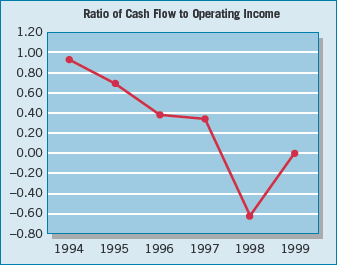
Similar to W. T. Grant in the chapter opening story, Xerox was reporting earnings growth in the years leading up to its financial breakdown in 2000 but teetering near bankruptcy in 2001. However, Xerox's ratio of cash flow to earnings showed a declining trend and became negative well before its revenue recognition practices were revealed. The trend revealed in the graph should have given any analyst reason to investigate Xerox further. As one analyst noted, "Earnings growth that exceeds the growth in operating cash flow cannot continue for extended periods and should be investigated."
Source: Adapted from Charles Mulford and Eugene Comiskey, The Financial Numbers Game: Detecting Creative Accounting Practices (New York: John Wiley & Sons, 2002), Chapter 11, by permission.
When numerous adjustments are necessary or other complicating factors are present, companies often use a worksheet to assemble and classify the data that will appear on the statement of cash flows. The worksheet (a spreadsheet when using computer software) is merely a device that aids in the preparation of the statement. Its use is optional. Illustration 23-37 shows the skeleton format of the work-sheet for preparation of the statement of cash flows using the indirect method.
The following guidelines are important in using a worksheet.
In the balance sheet accounts section, list accounts with debit balances separately from those with credit balances. This means, for example, that Accumulated Depreciation is listed under credit balances and not as a contra account under debit balances. Enter the beginning and ending balances of each account in the appropriate columns. Then, enter the transactions that caused the change in the account balance during the year as reconciling items in the two middle columns.
After all reconciling items have been entered, each line pertaining to a balance sheet account should foot across. That is, the beginning balance plus or minus the reconciling item(s) must equal the ending balance. When this agreement exists for all balance sheet accounts, all changes in account balances have been reconciled.
The bottom portion of the worksheet consists of the operating, investing, and financing activities sections. Accordingly, it provides the information necessary to prepare the formal statement of cash flows. Enter inflows of cash as debits in the reconciling columns, and outflows of cash as credits in the reconciling columns. Thus, in this section, a company would enter the sale of equipment for cash at book value as a debit under inflows of cash from investing activities. Similarly, it would enter the purchase of land for cash as a credit under outflows of cash from investing activities.
Do not enter in any journal or post to any account the reconciling items shown in the worksheet. These items do not represent either adjustments or corrections of the balance sheet accounts. They are used only to facilitate the preparation of the statement of cash flows.
The preparation of a worksheet involves the following steps.
Step 1. Enter the balance sheet accounts and their beginning and ending balances in the balance sheet accounts section.
Step 2. Enter the data that explain the changes in the balance sheet accounts (other than cash) and their effects on the statement of cash flows in the reconciling columns of the worksheet.
Step 3. Enter the increase or decrease in cash on the cash line and at the bottom of the worksheet. This entry should enable the totals of the reconciling columns to be in agreement.
To illustrate the preparation and use of a worksheet and to illustrate the reporting of some of the special problems discussed in the prior section, we present a comprehensive example for Satellite Corporation. Again, the indirect method serves as the basis for the computation of net cash provided by operating activities. Illustrations 23-38 and 23-39 (on page 1276) present the balance sheet, combined statement of income and retained earnings, and additional information for Satellite Corporation. The discussion that follows these financial statements provides additional explanations related to the preparation of the worksheet.
The following discussion explains the individual adjustments that appear on the work-sheet in Illustration 23-40 (page 1281). Because cash is the basis for the analysis, Satellite reconciles the cash account last. Because income is the first item that appears on the statement of cash flows, it is handled first.
Net income for the period is $117,000. The entry for it on the worksheet is as follows.
Satellite reports net income on the bottom section of the worksheet. This is the starting point for preparation of the statement of cash flows (under the indirect method).
A stock dividend and a cash dividend also affected retained earnings. The retained earnings statement reports a stock dividend of $15,000. The worksheet entry for this transaction is as follows.

The issuance of stock dividends is not a cash operating, investing, or financing item. Therefore, although the company enters this transaction on the worksheet for reconciling purposes, it does not report it in the statement of cash flows.
The $6,000 cash dividend paid represents a financing activity cash outflow. Satellite makes the following worksheet entry:
The company reconciles the beginning and ending balances of retained earnings by entry of the three items above.
The increase in accounts receivable (net) of $53,000 represents adjustments that did not result in cash inflows during 2010. As a result, the company would deduct from net income the increase of $53,000. Satellite makes the following worksheet entry.
The increase in inventories of $152,000 represents an operating use of cash. The incremental investment in inventories during the year reduces cash without increasing the cost of goods sold. Satellite makes the following worksheet entry.
The decrease in prepaid expenses of $500 represents a charge in the income statement for which there was no cash outflow in the current period. Satellite should add that amount back to net income through the following entry.

Satellite's investment in the stock of Porter Co. increased $3,500. This amount reflects Satellite's share of net income earned by Porter (its equity investee) during the current year. Although Satellite's revenue, and therefore its net income increased $3,500 by recording Satellite's share of Porter Co.'s net income, no cash (dividend) was provided. Satellite makes the following worksheet entry.

Satellite purchased land in the amount of $60,000 through the issuance of a long-term note payable. This transaction did not affect cash. It is a significant noncash investing/ financing transaction that the company would disclose either in a separate schedule below the statement of cash flows or in the accompanying notes. Satellite makes the following entry to reconcile the worksheet.

In addition to the noncash transaction involving the issuance of a note to purchase land, the Land account was decreased by the condemnation proceedings. The following worksheet entry records the receipt of $18,500 for land having a book value of $10,500.

In reconciling net income to net cash flow from operating activities, Satellite deducts from net income the extraordinary gain of $8,000. The reason is that the transaction that gave rise to the gain is an item whose cash effect is already classified as an investing cash inflow. The Land account is now reconciled.
An analysis of Equipment and Accumulated Depreciation shows that a number of transactions have affected these accounts. The company purchased equipment in the amount of $53,000 during the year. Satellite records this transaction on the worksheet as follows.

In addition, Satellite sold at a loss of $1,500 equipment with a book value of $5,500. It records this transaction as follows.

The proceeds from the sale of the equipment provided cash of $4,000. In addition, the loss on the sale of the equipment has reduced net income, but did not affect cash. Therefore, the company adds back to net income the amount of the loss, in order to accurately report cash provided by operating activities.
Satellite reported depreciation on the equipment at $11,500 and recorded it on the worksheet as follows.

The company adds depreciation expense back to net income because that expense reduced income but did not affect cash.
Finally, the company made a major repair to the equipment. It charged this expenditure, in the amount of $11,000, to Accumulated Depreciation—Equipment. This expenditure required cash, and so Satellite makes the following worksheet entry.

After adjusting for the foregoing items, Satellite has reconciled the balances in the Equipment and related Accumulated Depreciation accounts.
Depreciation expense on the buildings of $3,100 and amortization of trademark of $2,400 are both expenses in the income statement that reduced net income but did not require cash outflows in the current period. Satellite makes the following worksheet entry.

Analysis of the remaining accounts indicates that changes in the Accounts Payable, Accrued Liabilities, Income Tax Payable, Premium on Bonds Payable, and Deferred Tax Liability balances resulted from charges or credits to net income that did not affect cash. The company should individually analyze each of these items and enter them in the worksheet. The following compound entry summarizes these noncash, income-related items.
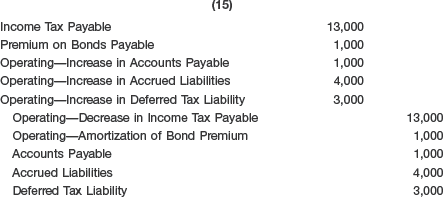
Comparison of the common stock balances and the additional paid-in capital balances shows that transactions during the year affected these accounts. First, Satellite issues a stock dividend of 2 percent to stockholders. As the discussion of worksheet entry (2) indicated, no cash was provided or used by the stock dividend transaction. In addition to the shares issued via the stock dividend, Satellite sold shares of common stock at $16 per share. The company records this transaction as follows.

Also, the company purchased shares of its common stock in the amount of $17,000. It records this transaction on the worksheet as follows.

The final entry to reconcile the change in cash and to balance the worksheet is shown below. The $7,000 amount is the difference between the beginning and ending cash balance.

Once the company has determined that the differences between the beginning and ending balances per the worksheet columns have been accounted for, it can total the reconciling transactions columns, and they should balance. Satellite can prepare the statement of cash flows entirely from the items and amounts that appear at the bottom of the worksheet under "Statement of Cash Flows Effects," as shown in Illustration 23-40 (on page 1281).
Illustration 23-41 presents a formal statement of cash flows prepared from the data compiled in the lower portion of the worksheet.

As in U.S. GAAP, the statement of cash flows is a required statement for iGAAP. In addition, the content and presentation of an iGAAP balance sheet is similar to one used for U.S. GAAP. However, the disclosure requirements related to the statement of cash flows are more extensive under U.S. GAAP. IAS 7 ("Cash Flow Statements") provides the overall iGAAP requirements for cash flow information.
Companies preparing financial statements under iGAAP must prepare a statement of cash flows as an integral part of the financial statements.
Both iGAAP and U.S. GAAP require that the statement of cash flows should have three major sections— operating, investing, and financing—along with changes in cash and cash equivalents.
Similar to U.S. GAAP, the cash flow statement can be prepared using either the indirect or direct method under iGAAP. In both U.S. and international settings, companies choose for the most part to use the indirect method for reporting net cash flows from operating activities.
iGAAP encourages companies to disclose the aggregate amount of cash flows that are attributable to the increase in operating capacity separately from those cash flows that are required to maintain operating capacity.
The definition of cash equivalents used in iGAAP is similar to that used in U.S. GAAP. A major difference is that in certain situations bank overdrafts are considered part of cash and cash equivalents under iGAAP (which is not the case in U.S. GAAP). Under U.S. GAAP, bank overdrafts are classified as financing activities.
iGAAP requires that noncash investing and financing activities be excluded from the statement of cash flows. Instead, these noncash activities should be reported elsewhere. This requirement is interpreted to mean that noncash investing and financing activities should be disclosed in the notes to the financial statements instead of in the financial statements. Under U.S. GAAP, companies may present this information in the cash flow statement.
One area where there can be substantive differences between iGAAP and U.S. GAAP relates to the classification of interest, dividends, and taxes. The following table indicates the differences between the two approaches.
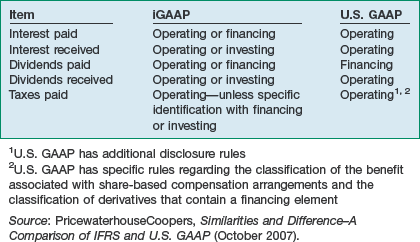
As indicated, the major difference is that iGAAP provides more alternatives for disclosing certain items.
Presently, the FASB and the IASB are involved in a joint project on the presentation and organization of information in the financial statements. With respect to the cash flow statement specifically, the notion of cash equivalents will probably not be retained. The definition of cash in the existing literature would be retained, and the statement of cash flows would present information on changes in cash only. In addition, the FASB favors presentation of operating cash flows using the direct method only. However, the majority of IASB members express a preference for not requiring use of the direct method of reporting operating cash flows. So the two Boards will have to resolve their differences in this area in order to issue a converged standard for the statement of cash flows.
FASB Codification References
FASB ASC 230-10-10-2. [Predecessor literature: "The Statement of Cash Flows," Statement of Financial Accounting Standards No. 95 (Stamford, Conn.: FASB, 1987), pars. 4 and 5.]
FASB ASC 230-10-45-18 through 21. [Predecessor literature: "Statement of Cash Flows—Exemption of Certain Enterprises and Classification of Cash Flows from Certain Securities Acquired for Resale (amended)," Statement of Financial Accounting Standards No. 102 (February 1989).]
FASB ASC 230-10-45-31. [Predecessor literature: "The Statement of Cash Flows," Statement of Financial Accounting Standards No. 95 (Stamford, Conn.: FASB, 1987), pars. 27 and 30.]
FASB ASC 230-10-45-25. [Predecessor literature: "Statement of Cash Flows," Statement of Financial Accounting Standards No. 95 (Stamford, Conn.: FASB, 1987), pars. 107 and 111.]
FASB ASC 320-10-45-11. [Predecessor literature: "Accounting for Certain Investments in Debt and Equity Securities," Statement of Financial Accounting Standards No. 115 (Norwalk, Conn.: 1993), par. 118.]
FASB ASC 320-10-45-11. [Predecessor literature: "Accounting for Certain Investments in Debt and Equity Securities," Statement of Financial Accounting Standards No. 115 (Norwalk, Conn.: 1993), par. 118.]
FASB ASC 230-10-45-14. [Predecessor literature: "Share-Based Payment," Statement of Financial Accounting Standard No. 123(R) (Norwalk, Conn.: FASB, 2004), par. 68.]

What is the purpose of the statement of cash flows? What information does it provide?
Of what use is the statement of cash flows?
Differentiate between investing activities, financing activities, and operating activities.
What are the major sources of cash (inflows) in a statement of cash flows? What are the major uses (outflows) of cash?
Identify and explain the major steps involved in preparing the statement of cash flows.
Identify the following items as (1) operating, (2) investing, or (3) financing activities: purchase of land; payment of dividends; cash sales; and purchase of treasury stock.
Unlike the other major financial statements, the statement of cash flows is not prepared from the adjusted trial balance. From what sources does the information to prepare this statement come, and what information does each source provide?
Why is it necessary to convert accrual-based net income to a cash basis when preparing a statement of cash flows?
Differentiate between the direct method and the indirect method by discussing each method.
Broussard Company reported net income of $3.5 million in 2010. Depreciation for the year was $520,000; accounts receivable increased $500,000; and accounts payable increased $300,000. Compute net cash flow from operating activities using the indirect method.
Collinsworth Co. reported sales on an accrual basis of $100,000. If accounts receivable increased $30,000, and the allowance for doubtful accounts increased $9,000 after a write-off of $2,000, compute cash sales.
Your roommate is puzzled. During the last year, the company in which she is a stockholder reported a net loss of $675,000, yet its cash increased $321,000 during the same period of time. Explain to your roommate how this situation could occur.
The board of directors of Gifford Corp. declared cash dividends of $260,000 during the current year. If dividends payable was $85,000 at the beginning of the year and $90,000 at the end of the year, how much cash was paid in dividends during the year?
Explain how the amount of cash payments to suppliers is computed under the direct method.
The net income for Letterman Company for 2010 was $320,000. During 2010, depreciation on plant assets was $124,000, amortization of patent was $40,000, and the company incurred a loss on sale of plant assets of $21,000. Compute net cash flow from operating activities.
Each of the following items must be considered in preparing a statement of cash flows for Blackwell Inc. for the year ended December 31, 2010. State where each item is to be shown in the statement, if at all.
Plant assets that had cost $18,000 6½ years before and were being depreciated on a straight-line basis over 10 years with no estimated scrap value were sold for $4,000.
During the year, 10,000 shares of common stock with a stated value of $20 a share were issued for $41 a share.
Uncollectible accounts receivable in the amount of $22,000 were written off against the Allowance for Doubtful Accounts.
The company sustained a net loss for the year of $50,000. Depreciation amounted to $22,000, and a gain of $9,000 was realized on the sale of available-for-sale securities for $38,000 cash.
Classify the following items as (1) operating, (2) investing, (3) financing, or (4) significant noncash investing and financing activities, using the direct method.
Cash payments to employees.
Redemption of bonds payable.
Sale of building at book value.
Cash payments to suppliers.
Exchange of equipment for furniture.
Issuance of preferred stock.
Cash received from customers.
Purchase of treasury stock.
Issuance of bonds for land.
Payment of dividends.
Purchase of equipment.
Cash payments for operating expenses.
Stan Conner and Mark Stein were discussing the presentation format of the statement of cash flows of Bombeck Co. At the bottom of Bombeck's statement of cash flows was a separate section entitled "Noncash investing and financing activities." Give three examples of significant noncash transactions that would be reported in this section.
During 2010, Simms Company redeemed $2,000,000 of bonds payable for $1,880,000 cash. Indicate how this transaction would be reported on a statement of cash flows, if at all.
What are some of the arguments in favor of using the indirect (reconciliation) method as opposed to the direct method for reporting a statement of cash flows?
Why is it desirable to use a worksheet when preparing a statement of cash flows? Is a worksheet required to prepare a statement of cash flows?





Sale of land $180,000
Purchase of inventory $845,000
Purchase of treasury stock $72,000
Purchase of equipment $415,000
Issuance of common stock $320,000
Purchase of available-for-sale securities $59,000
Compute the amount Wainwright should report as net cash provided (used) by investing activities in its statement of cash flows.

Payment of accounts payable $770,000
Issuance of common stock $250,000
Payment of dividends $350,000
Collection of note receivable $100,000
Issuance of bonds payable $510,000
Purchase of treasury stock $46,000
Compute the amount Stansfield should report as net cash provided (used) by financing activities in its 2010 statement of cash flows.


Items
____ (a) Purchase of land and building.
____ (b) Decrease in accounts receivable.
____ (c) Issuance of stock.
____ (d) Depreciation expense.
____ (e) Sale of land at book value.
____ (f) Sale of land at a gain.
____ (g) Payment of dividends.
____ (h) Increase in accounts receivable.
____ (i) Purchase of available-for-sale investment.
____ (j) Increase in accounts payable.
____ (k) Decrease in accounts payable.
____ (l) Loan from bank by signing note.
____ (m) Purchase of equipment using a note.
____ (n) Increase in inventory.
____ (o) Issuance of bonds.
____ (p) Retirement of bonds payable.
____ (q) Sale of equipment at a loss.
____ (r) Purchase of treasury stock.


The following accounts increased during 2010: accounts receivable $12,000; inventory $11,000; accounts payable $13,000. Prepare the cash flows from operating activities section of Bloom's 2010 statement of cash flows using the direct method.



1/1/10
12/31/10
Inventory
$95,000
$113,000
Accounts payable
61,000
69,000
For 2010, cost of goods sold was $500,000. Compute Moxley's 2010 cash payments to suppliers.



In 2010, Loveless had the following activity in selected accounts.

Prepare Loveless's cash flows from operating activities section of the statement of cash flows using (a) the direct method and (b) the indirect method.

Accounts receivable
$11,000 increase
Available-for-sale securities
16,000 increase
Inventory
7,400 increase
Nontrade note payable
15,000 decrease
Accounts payable
12,300 increase
Compute net cash provided by operating activities.


Prepare Leppard's journal entry to record the transaction.
Indicate the effect the transaction has on cash.
Indicate how the transaction is reported on the statement of cash flows.

Net income is $317,000.
Cash dividends declared and paid totaled $120,000.
Equipment was purchased for $114,000.
Equipment that originally cost $40,000 and had accumulated depreciation of $32,000 was sold for $10,000.

Pension expense exceeds amount funded.
Redemption of bonds payable.
Sale of building at book value.
Depreciation.
Exchange of equipment for furniture.
Issuance of capital stock.
Amortization of intangible assets.
Purchase of treasury stock.
Issuance of bonds for land.
Payment of dividends.
Increase in interest receivable on notes receivable.
Purchase of equipment.
Instructions
Classify the items as (1) operating—add to net income; (2) operating—deduct from net income; (3) investing; (4) financing; or (5) significant noncash investing and financing activities. Use the indirect method.

Plant assets that had cost $25,000 6 years before and were being depreciated on a straight-line basis over 10 years with no estimated scrap value were sold at the beginning of the year for $5,300.
During the year, 10,000 shares of common stock with a stated value of $10 a share were issued for $33 a share.
Uncollectible accounts receivable in the amount of $27,000 were written off against the Allowance for Doubtful Accounts.
The company sustained a net loss for the year of $50,000. Depreciation amounted to $22,000, and a gain of $9,000 was realized on the sale of land for $39,000 cash.
A 3-month U.S. Treasury bill was purchased for $100,000. The company uses a cash and cash-equivalent basis for its cash flow statement.
Patent amortization for the year was $20,000.
The company exchanged common stock for a 70% interest in Plumlee Co. for $900,000.
During the year, treasury stock costing $47,000 was purchased.
Instructions
State where each item is to be shown in the statement of cash flows, if at all.

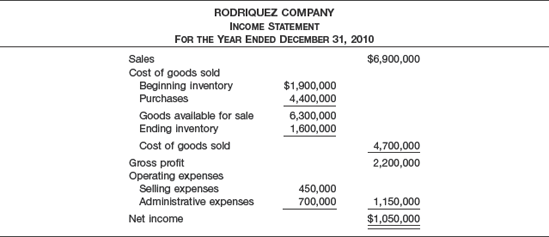
Additional information:
Accounts receivable decreased $310,000 during the year.
Prepaid expenses increased $170,000 during the year.
Accounts payable to suppliers of merchandise decreased $275,000 during the year.
Accrued expenses payable decreased $120,000 during the year.
Administrative expenses include depreciation expense of $60,000.
Instructions
Prepare the operating activities section of the statement of cash flows for the year ended December 31, 2010, for Rodriquez Company, using the indirect method.

Instructions
Prepare the operating activities section of the statement of cash flows using the direct method.


Norman's balance sheet contained the following comparative data at December 31.
2010
2009
Accounts receivable
$37,000
$59,000
Accounts payable
46,000
31,000
Income taxes payable
4,000
8,500
(Accounts payable pertains to operating expenses.)
Instructions
Prepare the operating activities section of the statement of cash flows using the direct method.

Instructions
Prepare the operating activities section of the statement of cash flows using the indirect method.

Situation A:
Chenowith Co. reports revenues of $200,000 and operating expenses of $110,000 in its first year of operations, 2010. Accounts receivable and accounts payable at year-end were $71,000 and $39,000, respectively. Assume that the accounts payable related to operating expenses. Ignore income taxes.
Instructions
Using the direct method, compute net cash provided (used) by operating activities.
Situation B:
The income statement for Edgebrook Company shows cost of goods sold $310,000 and operating expenses (exclusive of depreciation) $230,000. The comparative balance sheet for the year shows that inventory increased $21,000, prepaid expenses decreased $8,000, accounts payable (related to merchandise) decreased $17,000, and accrued expenses payable increased $11,000.
Instructions
Compute (a) cash payments to suppliers and (b) cash payments for operating expenses.

Messner purchased 100 shares of treasury stock at a cost of $20 per share. These shares were then resold at $25 per share.
Messner sold 100 shares of IBM common at $200 per share. The acquisition cost of these shares was $165 per share. This investment was shown on Messner's December 31, 2009, balance sheet as an available-for-sale security.
Messner revised its estimate for bad debts. Before 2010, Messner's bad debt expense was 1% of its net sales. In 2010, this percentage was increased to 2%. Net sales for 2010 were $500,000, and net accounts receivable decreased by $12,000 during 2010.
Messner issued 500 shares of its $10 par common stock for a patent. The market value of the shares on the date of the transaction was $23 per share.
Depreciation expense is $39,000.
Messner Co. holds 30% of the Sanchez Company's common stock as a long-term investment. Sanchez Company reported $27,000 of net income for 2010.
Sanchez Company paid a total of $2,000 of cash dividends to all investees in 2010.
Messner declared a 10% stock dividend. One thousand shares of $10 par common stock were distributed. The market price at date of issuance was $20 per share.
Instructions
Prepare a schedule that shows the net cash flow from operating activities using the indirect method. Assume no items other than those listed above affected the computation of 2010 net cash flow from operating activities.

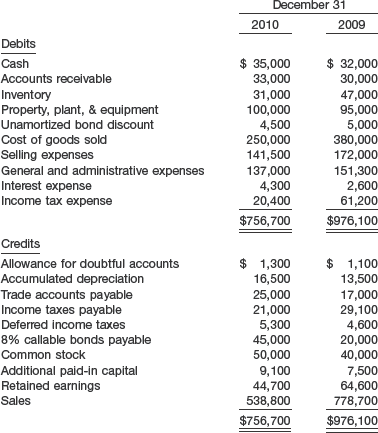
Additional information:
Waubansee purchased $5,000 in equipment during 2010.
Waubansee allocated one-third of its depreciation expense to selling expenses and the remainder to general and administrative expenses.
Bad debt expense for 2010 was $5,000, and writeoffs of uncollectible accounts totaled $3,800.
Instructions
Determine what amounts Waubansee should report in its statement of cash flows for the year ended December 31, 2010, for the following items.
Cash collected from customers.
Cash paid to suppliers.
Cash paid for interest.
Cash paid for income taxes.
Cash paid for selling expenses.


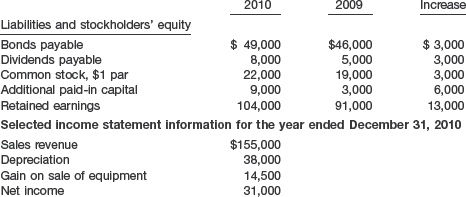
Additional information:
During 2010, equipment costing $45,000 was sold for cash.
Accounts receivable relate to sales of merchandise.
During 2010, $25,000 of bonds payable were issued in exchange for property, plant, and equipment. There was no amortization of bond discount or premium.
Instructions
Determine the category (operating, investing, or financing) and the amount that should be reported in the statement of cash flows for the following items.
Payments for purchase of property, plant, and equipment.
Proceeds from the sale of equipment.
Cash dividends paid.
Redemption of bonds payable.

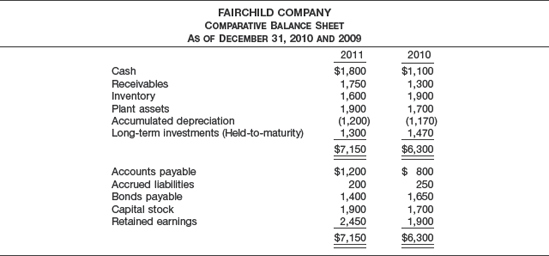
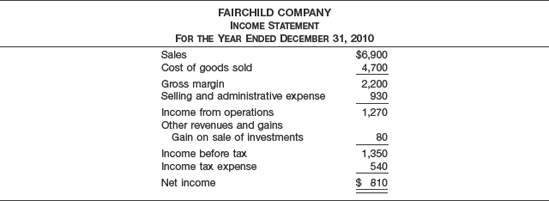
Additional information:
During the year, $70 of common stock was issued in exchange for plant assets. No plant assets were sold in 2010. Cash dividends were $260.
Instructions
Prepare a statement of cash flows using the indirect method.

Instructions
Prepare a statement of cash flows using the direct method. (Do not prepare a reconciliation schedule.)

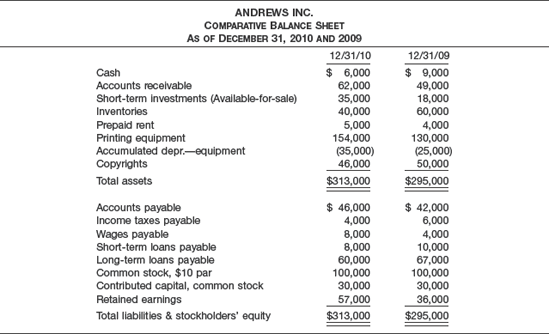
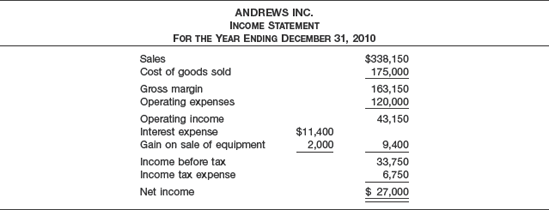
Additional information:
Dividends in the amount of $6,000 were declared and paid during 2010.
Depreciation expense and amortization expense are included in operating expenses.
No unrealized gains or losses have occurred on the investments during the year.
Equipment that had a cost of $30,000 and was 70% depreciated was sold during 2010.
Instructions
Prepare a statement of cash flows using the direct method. (Do not prepare a reconciliation schedule.)

Instructions
Prepare a statement of cash flows using the indirect method.

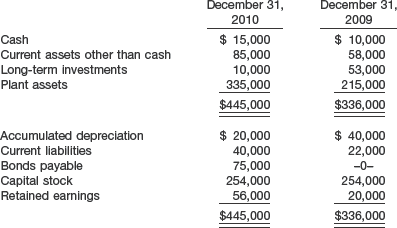
Additional information:
Held-to-maturity securities carried at a cost of $43,000 on December 31, 2009, were sold in 2010 for $34,000. The loss (not extraordinary) was incorrectly charged directly to Retained Earnings.
Plant assets that cost $60,000 and were 80% depreciated were sold during 2010 for $8,000. The loss (not extraordinary) was incorrectly charged directly to Retained Earnings.
Net income as reported on the income statement for the year was $59,000.
Dividends paid amounted to $10,000.
Depreciation charged for the year was $28,000.
Instructions
Prepare a statement of cash flows for the year 2010 using the indirect method.

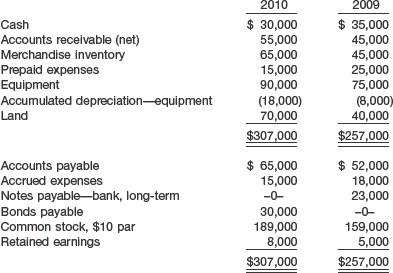
Land was acquired for $30,000 in exchange for common stock, par $30,000, during the year; all equipment purchased was for cash. Equipment costing $13,000 was sold for $3,000; book value of the equipment was $6,000. Cash dividends of $9,000 were declared and paid during the year.
Instructions
Compute net cash provided (used) by:
Operating activities.
Investing activities.
Financing activities.


During 2010 the following occurred.
A tract of land was purchased for $11,000.
Bonds payable in the amount of $20,000 were retired at par.
An additional $10,000 in capital stock was issued at par.
Dividends totaling $9,375 were paid to stockholders.
Net income was $30,250 after deducting depreciation of $13,500.
Land was purchased through the issuance of $22,500 in bonds.
Ochoa Inc. sold part of its investment portfolio for $12,875. This transaction resulted in a gain of $2,000 for the company. The company classifies the investments as available-for-sale.
Both current assets (other than cash) and current liabilities remained at the same amount.
Instructions
Prepare a statement of cash flows for 2010 using the indirect method.
Prepare the condensed balance sheet for Ochoa Inc. as it would appear at December 31, 2010.

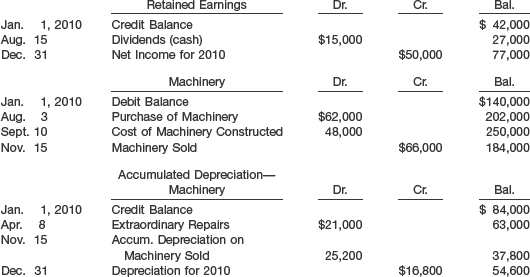
Instructions
From the postings in the accounts above, indicate how the information is reported on a statement of cash flows by preparing a partial statement of cash flows using the indirect method. The loss on sale of equipment (November 15) was $5,800.

Instructions
Prepare entries in journal form for all adjustments that should be made on a worksheet for a statement of cash flows.

Convertible bonds payable with a par value of $300,000 were exchanged for unissued common stock with a par value of $300,000. The market price of both types of securities was par.
The net income for the year was $360,000.
Depreciation expense for the building was $90,000.
Some old office equipment was traded in on the purchase of some newer office equipment and the following entry was made. (The exchange has commercial substance.)

The Gain on Disposal of Plant Assets was credited to current operations as ordinary income.
Dividends in the amount of $123,000 were declared. They are payable in January of next year.
Instructions
Show by journal entries the adjustments that would be made on a worksheet for a statement of cash flows.

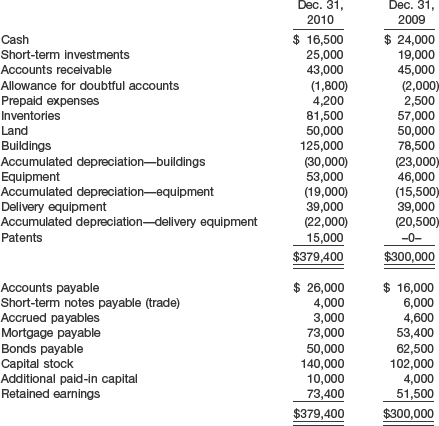
Dividends in the amount of $10,000 were declared and paid in 2010.
Instructions
From this information, prepare a worksheet for a statement of cash flows. Make reasonable assumptions as appropriate. The short-term investments are considered available-for-sale, and no unrealized gains or losses have occurred on these securities.


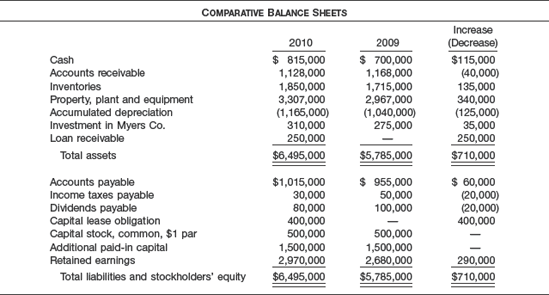
Additional information:
On December 31, 2009, Sullivan acquired 25% of Myers Co.'s common stock for $275,000. On that date, the carrying value of Myers's assets and liabilities, which approximated their fair values, was $1,100,000. Myers reported income of $140,000 for the year ended December 31, 2010. No dividend was paid on Myers's common stock during the year.
During 2010, Sullivan loaned $300,000 to TLC Co., an unrelated company. TLC made the first semi-annual principal repayment of $50,000, plus interest at 10%, on December 31, 2010.
On January 2, 2010, Sullivan sold equipment costing $60,000, with a carrying amount of $38,000, for $40,000 cash.
On December 31, 2010, Sullivan entered into a capital lease for an office building. The present value of the annual rental payments is $400,000, which equals the fair value of the building. Sullivan made the first rental payment of $60,000 when due on January 2, 2011.
Net income for 2010 was $370,000.
Sullivan declared and paid cash dividends for 2010 and 2009 as shown below.

Instructions
Prepare a statement of cash flows for Sullivan Corp. for the year ended December 31, 2010, using the indirect method.
(AICPA adapted)

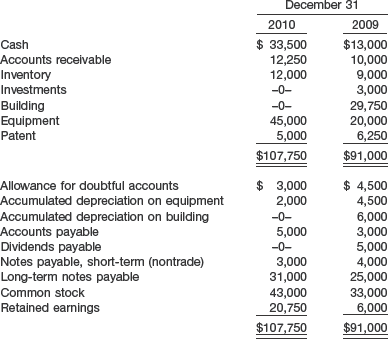
Additional data related to 2010 are as follows.
Equipment that had cost $11,000 and was 40% depreciated at time of disposal was sold for $2,500.
$10,000 of the long-term note payable was paid by issuing common stock.
Cash dividends paid were $5,000.
On January 1, 2010, the building was completely destroyed by a flood. Insurance proceeds on the building were $30,000 (net of $2,000 taxes).
Investments (available-for-sale) were sold at $1,700 above their cost. The company has made similar sales and investments in the past.
Cash was paid for the acquisition of equipment.
A long-term note for $16,000 was issued for the acquisition of equipment.
Interest of $2,000 and income taxes of $6,500 were paid in cash.
Instructions
Prepare a statement of cash flows using the indirect method. Flood damage is unusual and infrequent in that part of the country.

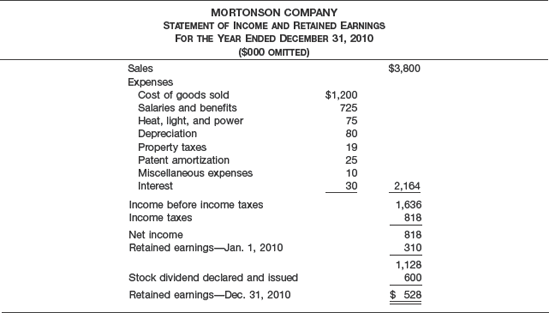
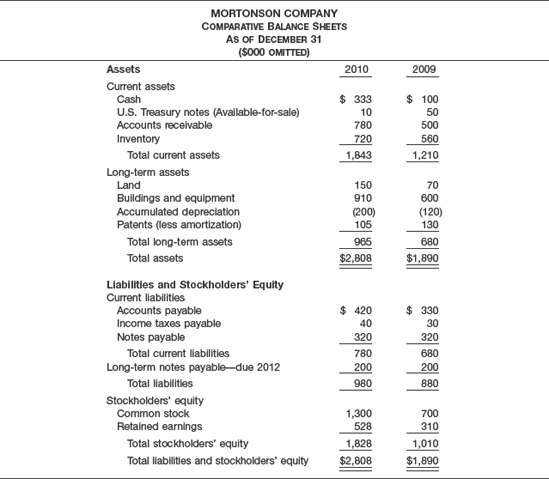
Instructions
Prepare a statement of cash flows using the direct method. Changes in accounts receivable and accounts payable relate to sales and cost of goods sold. Do not prepare a reconciliation schedule.
(CMA adapted)

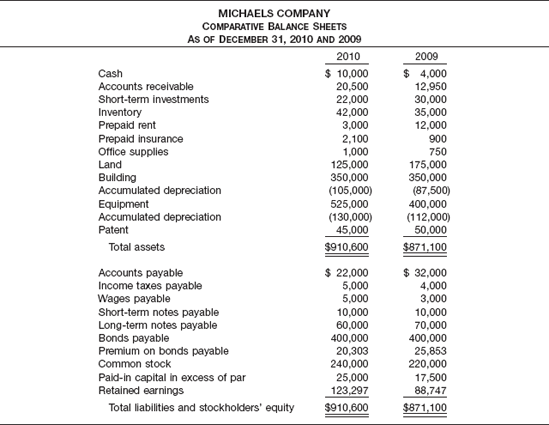
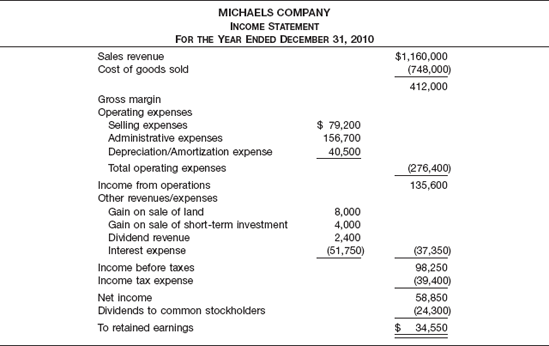
Instructions
Prepare a statement of cash flows for Michaels Company using the direct method accompanied by a reconciliation schedule. Assume the short-term investments are available-for-sale securities.

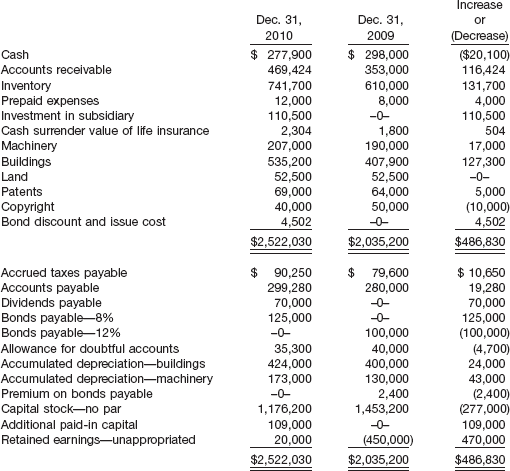

Your working papers from the audit contain the following information:
On April 1, 2010, the existing deficit was written off against paid-in capital created by reducing the stated value of the no-par stock.
On November 1, 2010, 29,600 shares of no-par stock were sold for $257,000. The board of directors voted to regard $5 per share as stated capital.
A patent was purchased for $15,000.
During the year, machinery that had a cost basis of $16,400 and on which there was accumulated depreciation of $5,200 was sold for $9,000. No other plant assets were sold during the year.
The 12%, 20-year bonds were dated and issued on January 2, 1998. Interest was payable on June 30 and December 31. They were sold originally at 106. These bonds were retired at 100.9 plus accrued interest on March 31, 2010.
The 8%, 40-year bonds were dated January 1, 2010, and were sold on March 31 at 97 plus accrued interest. Interest is payable semiannually on June 30 and December 31. Expense of issuance was $839.
Alexander Corporation acquired 70% control in Crimson Company on January 2, 2010, for $100,000. The income statement of Crimson Company for 2010 shows a net income of $15,000.
Extraordinary repairs to buildings of $7,200 were charged to Accumulated Depreciation—Buildings.
Interest paid in 2010 was $10,500 and income taxes paid were $34,000.
Instructions
From the information given, prepare a statement of cash flows using the indirect method. A worksheet is not necessary, but the principal computations should be supported by schedules or skeleton ledger accounts. The company uses straight-line amortization for bond interest.

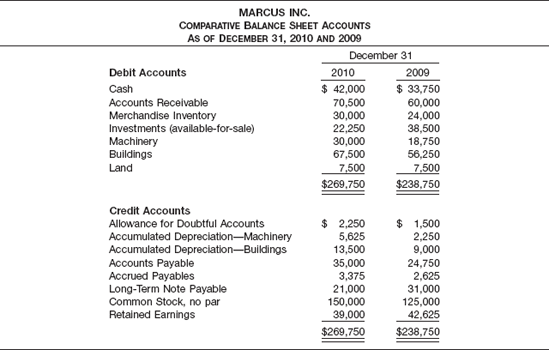
Additional data (ignoring taxes):
Net income for the year was $42,500.
Cash dividends declared and paid during the year were $21,125.
A 20% stock dividend was declared during the year. $25,000 of retained earnings was capitalized.
Investments that cost $25,000 were sold during the year for $28,750.
Machinery that cost $3,750, on which $750 of depreciation had accumulated, was sold for $2,200.
Marcus's 2010 income statement follows (ignoring taxes).

Instructions
Compute net cash flow from operating activities using the direct method.
Prepare a statement of cash flows using the indirect method.

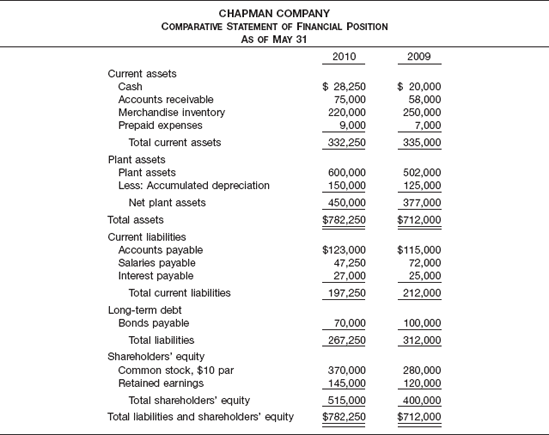
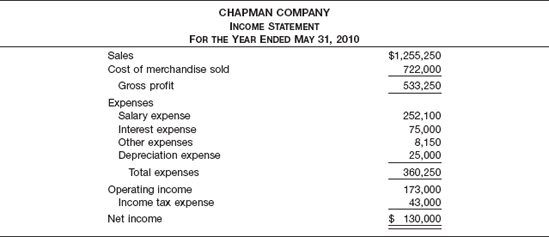
The following is additional information concerning Chapman's transactions during the year ended May 31, 2010.
All sales during the year were made on account.
All merchandise was purchased on account, comprising the total accounts payable account.
Plant assets costing $98,000 were purchased by paying $28,000 in cash and issuing 7,000 shares of stock.
The "other expenses" are related to prepaid items.
All income taxes incurred during the year were paid during the year.
In order to supplement its cash, Chapman issued 2,000 shares of common stock at par value.
There were no penalties assessed for the retirement of bonds.
Cash dividends of $105,000 were declared and paid at the end of the fiscal year.
Instructions
Compare and contrast the direct method and the indirect method for reporting cash flows from operating activities.
Prepare a statement of cash flows for Chapman Company for the year ended May 31, 2010, using the direct method. Be sure to support the statement with appropriate calculations. (A reconciliation of net income to net cash provided is not required.)
Using the indirect method, calculate only the net cash flow from operating activities for Chapman Company for the year ended May 31, 2010.

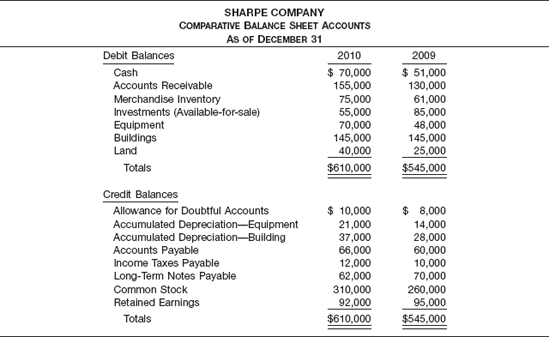
Additional data:
Equipment that cost $10,000 and was 60% depreciated was sold in 2010.
Cash dividends were declared and paid during the year.
Common stock was issued in exchange for land.
Investments that cost $35,000 were sold during the year.
There were no write-offs of uncollectible accounts during the year.
Sharpe's 2010 income statement is as follows.

Instructions
Compute net cash provided by operating activities under the direct method.
Prepare a statement of cash flows using the indirect method.

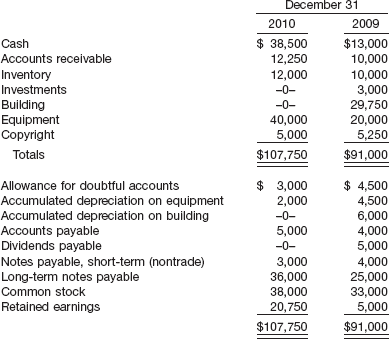
Additional data related to 2010 are as follows.
Equipment that had cost $11,000 and was 30% depreciated at time of disposal was sold for $2,500.
$5,000 of the long-term note payable was paid by issuing common stock.
Cash dividends paid were $5,000.
On January 1, 2010, the building was completely destroyed by a flood. Insurance proceeds on the building were $33,000 (net of $4,000 taxes).
Investments (available-for-sale) were sold at $1,500 above their cost. The company has made similar sales and investments in the past.
Cash and long-term note for $16,000 were given for the acquisition of equipment.
Interest of $2,000 and income taxes of $5,000 were paid in cash.
Instructions
Use the indirect method to analyze the above information and prepare a statement of cash flows for Dingel. Flood damage is unusual and infrequent in that part of the country.
What would you expect to observe in the operating, investing, and financing sections of a statement of cash flows of:
A severely financially troubled firm?
A recently formed firm that is experiencing rapid growth?
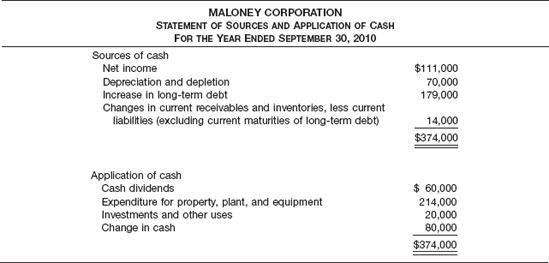
The following additional information relating to Maloney Corporation is available for the year ended September 30, 2010.
Wage and salary expense attributable to stock option plans was $25,000 for the year.
Expenditures for property, plant, and equipment Proceeds from retirements of property, plant, and equipment Net expenditures

A stock dividend of 10,000 shares of Maloney Corporation common stock was distributed to common stockholders on April 1, 2010, when the per share market price was $7 and par value was $1.
On July 1, 2010, when its market price was $6 per share, 16,000 shares of Maloney Corporation common stock were issued in exchange for 4,000 shares of preferred stock.
Depreciation expense Depletion expense

Increase in long-term debt Retirement of debt Net increase

Instructions
In general, what are the objectives of a statement of the type shown above for Maloney Corporation? Explain.
Identify the weaknesses in the form and format of Maloney Corporation's statement of cash flows without reference to the additional information. (Assume adoption of the indirect method.)
For each of the six items of additional information for the statement of cash flows, indicate the preferable treatment and explain why the suggested treatment is preferable.
(AICPA adapted)
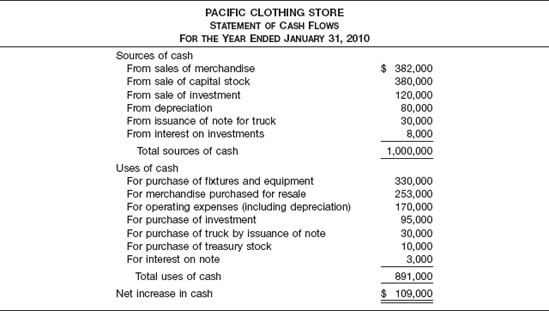
Teresa claims that Pacific's statement of cash flows is an excellent portrayal of a superb first year, with cash increasing $109,000. Lenny replies that it was not a superb first year—that the year was an operating failure, the statement was incorrectly presented, and $109,000 is not the actual increase in cash.
Instructions
With whom do you agree, Teresa or Lenny? Explain your position.
Using the data provided, prepare a statement of cash flows in proper indirect method form. The only noncash items in income are depreciation and the gain from the sale of the investment (purchase and sale are related).
CA23-3 (SCF Theory and Analysis of Transactions) Ashley Company is a young and growing producer of electronic measuring instruments and technical equipment. You have been retained by Ashley to advise it in the preparation of a statement of cash flows using the indirect method. For the fiscal year ended October 31, 2010, you have obtained the following information concerning certain events and transactions of Ashley.
The amount of reported earnings for the fiscal year was $700,000, which included a deduction for an extraordinary loss of $110,000 (see item 5 below).
Depreciation expense of $315,000 was included in the income statement.
Uncollectible accounts receivable of $40,000 were written off against the allowance for doubtful accounts. Also, $51,000 of bad debt expense was included in determining income for the fiscal year, and the same amount was added to the allowance for doubtful accounts.
A gain of $6,000 was realized on the sale of a machine. It originally cost $75,000, of which $30,000 was undepreciated on the date of sale.
On April 1, 2010, lightning caused an uninsured building loss of $110,000 ($180,000 loss, less reduction in income taxes of $70,000). This extraordinary loss was included in determining income as indicated in 1 above.
On July 3, 2010, building and land were purchased for $700,000. Ashley gave in payment $75,000 cash, $200,000 market value of its unissued common stock, and signed a $425,000 mortgage note payable.
On August 3, 2010, $800,000 face value of Ashley's 10% convertible debentures was converted into $150,000 par value of its common stock. The bonds were originally issued at face value.
Instructions
Explain whether each of the seven numbered items above is a source or use of cash, and explain how it should be disclosed in Ashley's statement of cash flows for the fiscal year ended October 31, 2010. If any item is neither a source nor a use of cash, explain why it is not, and indicate the disclosure, if any, that should be made of the item in Ashley's statement of cash flows for the fiscal year ended October 31, 2010.
Fixed assets that had cost $20,000 6½ years before and were being depreciated on a 10-year basis, with no estimated scrap value, were sold for $4,750.
During the year, goodwill of $15,000 was considered impaired and was completely written off to expense.
During the year, 500 shares of common stock with a stated value of $25 a share were issued for $32 a share.
The company sustained a net loss for the year of $2,100. Depreciation amounted to $2,000 and patent amortization was $400.
Uncollectible accounts receivable in the amount of $2,000 were written off against the Allowance for Doubtful Accounts.
Investments (available-for-sale) that cost $12,000 when purchased 4 years earlier were sold for $10,600. The loss was considered ordinary.
Bonds payable with a par value of $24,000 on which there was an unamortized bond premium of $2,000 were redeemed at 101. The gain was credited to ordinary income.
Instructions
For each item, state where it is to be shown in the statement and then how you would present the necessary information, including the amount. Consider each item to be independent of the others. Assume that correct entries were made for all transactions as they took place.
CA23-5 (Purpose and Elements of SCF) GAAP requires the statement of cash flows be presented when financial statements are prepared.
Instructions
Explain the purposes of the statement of cash flows.
List and describe the three categories of activities that must be reported in the statement of cash flows.
Identify and describe the two methods that are allowed for reporting cash flows from operations.
Describe the financial statement presentation of noncash investing and financing transactions. Include in your description an example of a noncash investing and financing transaction.
Thinking about the banker's comment, Barbara came up with what she believes is a good plan: With a more attractive statement of cash flows, the bank might be willing to provide long-term financing. To "window dress" cash flows, the company can sell its accounts receivables to factors and liquidate its raw materials inventories. These rather costly transactions would generate lots of cash. As the chief accountant for Brockman Guitar, it is your job to tell Barbara what you think of her plan.
Instructions
Answer the following questions.
What are the ethical issues related to Barbara Brockman's idea?
What would you tell Barbara Brockman?
The financial statements of P&G are presented in Appendix 5B or can be accessed at the book's companion website, www.wiley.com/college/kieso.
Instructions

Which method of computing net cash provided by operating activities does P&G use? What were the amounts of net cash provided by operating activities for the years 2005, 2006, and 2007? Which two items were most responsible for the increase in net cash provided by operating activities in 2007?
What was the most significant item in the cash flows used for investing activities section in 2007? What was the most significant item in the cash flows used for financing activities section in 2007?
Where is "deferred income taxes" reported in P&G's statement of cash flows? Why does it appear in that section of the statement of cash flows?
Where is depreciation reported in P&G's statement of cash flows? Why is depreciation added to net income in the statement of cash flows?
Instructions

What method of computing net cash provided by operating activities does Coca-Cola use? What method does PepsiCo use? What were the amounts of cash provided by operating activities reported by Coca-Cola and PepsiCo in 2007?
What was the most significant item reported by Coca-Cola and PepsiCo in 2007 in their investing activities sections? What is the most significant item reported by Coca-Cola and PepsiCo in 2007 in their financing activities sections?
What were these two companies' trends in net cash provided by operating activities over the period 2005 to 2007?
Where is "depreciation and amortization" reported by Coca-Cola and PepsiCo in their statements of cash flows? What is the amount and why does it appear in that section of the statement of cash flows?
Based on the information contained in Coca-Cola's and PepsiCo's financial statements, compute the following 2007 ratios for each company. These ratios require the use of statement of cash flows data. (These ratios were covered in Chapter 5.)
Current cash debt coverage ratio.
Cash debt coverage ratio.
What conclusions concerning the management of cash can be drawn from the ratios computed in (e)?
Founded in the early 1980s, the Vermont Teddy Bear Co. designs and manufactures American-made teddy bears and markets them primarily as gifts called Bear-Grams or Teddy Bear-Grams. Bear-Grams are personalized teddy bears delivered directly to the recipient for special occasions such as birthdays and anniversaries. The Shelburne, Vermont, company's primary markets are New York, Boston, and Chicago. Sales have jumped dramatically in recent years. Such dramatic growth has significant implications for cash flows. Provided below are the cash flow statements for two recent years for the company.
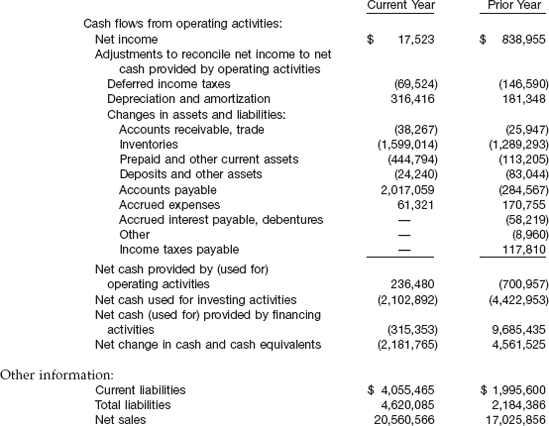
Instructions
Note that net income in the current year was only $17,523 compared to prior-year income of $838,955, but cash flow from operations was $236,480 in the current year and a negative $700,957 in the prior year. Explain the causes of this apparent paradox.
Evaluate Vermont Teddy Bear's liquidity, solvency, and profitability for the current year using cash flow-based ratios.
As noted in the chapter, there is international diversity in the preparation of the statement of cash flows. For example, under International Accounting Standards companies may choose how to classify dividends and interest in the cash flow statement. In some countries, like Brazil, a cash flow statement is not required. Embraer, a Brazilian aircraft manufacturer, prepared a statement of changes in financial position, rather than a statement of cash flows.
Instructions
Refer to Embraer's recent statement of changes in financial position below, to answer the following questions.
Briefly discuss at least two similarities between Embraer's statement of changes in financial position and a statement of cash flows prepared according to U.S. GAAP.
Briefly discuss at least two differences between Embraer's statement of changes in financial position and a statement of cash flows prepared according to U.S. GAAP.
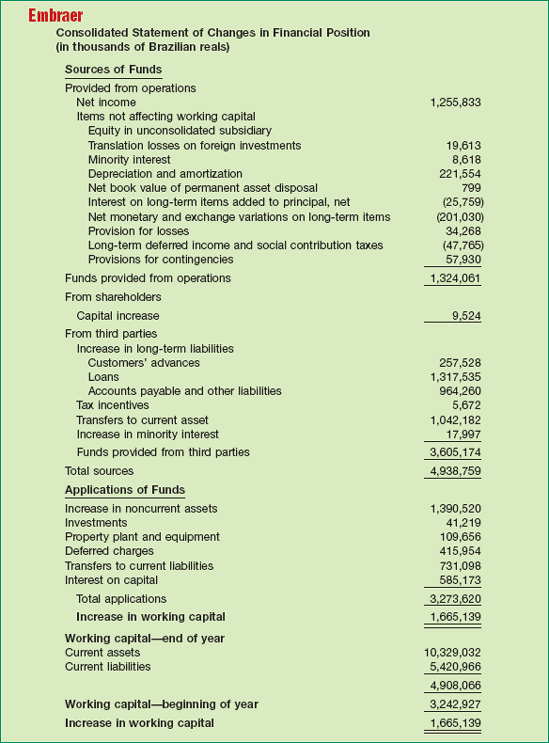
As part of the year-end accounting process for your company, you are preparing the statement of cash flows according to GAAP. One of your team, a finance major, believes the statement should be prepared to report the change in working capital, because analysts many times use working capital in ratio analysis. Your supervisor would like research conducted to verify the basis for preparing the statement of cash flows.
Instructions
Access the FASB Codification at http://asc.fasb.org/home to conduct research using the Codification Research System to prepare responses to the following items. Provide Codification references for your responses.
What is the primary objective for the statement of cash flows? Is working capital the basis for meeting this objective?
What information is provided in a statement of cash flows?
List some of the typical cash inflows and outflows from operations.
[415] The basis recommended by the FASB for the statement of cash flows is actually "cash and cash equivalents." Cash equivalents are short-term, highly liquid investments that are both:(a) readily convertible to known amounts of cash, and (b) so near their maturity that they present insignificant risk of changes in interest rates. Generally, only investments with original maturities of three months or less qualify under this definition. Examples of cash equivalents are Treasury bills, commercial paper, and money market funds purchased with cash that is in excess of immediate needs.
Although we use the term "cash" throughout our discussion and illustrations, we mean cash and cash equivalents when reporting the cash flows and the net increase or decrease in cash.
[416] Banks and brokers must classify cash flows from purchases and sales of loans and securities specifically for resale and carried at market value as operating activities. This requirement recognizes that for these firms these assets are similar to inventory in other businesses. [2]
[417] "Net cash flow from operating activities" is a generic phrase, replaced in the statement of cash flows with either "Net cash provided by operating activities" if operations increase cash, or "Net cash used by operating activities" if operations decrease cash.
[418] Accounting Trends and Techniques—2007 reports that out of its 600 surveyed companies, 594 (approximately 99 percent) used the indirect method, and only 6 used the direct method.
[419] A similar adjustment is required for unrealized gains or losses recorded on trading security investments or other financial assets and liabilities accounted for under the fair value option. Marking these assets and liabilities to fair value results in an increase or decrease in income, but there is no effect on cash flows.
[420] Accounting Trends and Techniques—2007 reports that of the 600 companies surveyed, 298 disclosed interest paid in notes to the financial statements, 282 disclosed interest paid at the bottom of the statement of cash flows, 6 disclosed interest paid within the statement of cash flows, and 14 reported no separate amount. Income taxes paid during the year were disclosed in a manner similar to interest payments.
[421] If the basis of the statement of cash flows is cash and cash equivalents and the short-term investment is considered a cash equivalent, then a company reports nothing in the statement because the transaction does not affect the balance of cash and cash equivalents. The Board notes that cash purchases of short term investments generally are part of the company's cash management activities rather than part of its operating, investing, or financing activities.
[422] Companies receive a tax deduction related to share-based compensation plans at the time employees exercise their options. The amount of the deduction is equal to the difference between the market price of the stock and the exercise price at the date the employee purchases the stock, which in most cases, is much larger than the total compensation expense recorded. When the tax deduction exceeds the total compensation recorded, this provides an additional cash inflow to the company. For example, in a recent year Cisco Systems reported an additional cash inflow related to its stock option plans equal to $537 million. Under GAAP, this tax-related cash inflow is reported in the financing section of the statement of cash flows. [7]
[423] For an insightful article on some weaknesses and limitations in the statement of cash flows, see Hugo Nurnberg, "Inconsistencies and Ambiguities in Cash Flow Statements Under FASB Statement No. 95," Accounting Horizons (June 1993), pp. 60–73. Nurnberg identifies the inconsistencies caused by the three-way classification of all cash receipts and cash payments, gross versus net of tax, the ambiguous disclosure requirements for noncash investing and financing transactions, and the ambiguous presentation of third-party financing transactions. See also Paul B. W. Miller, and Bruce P. Budge, "Nonarticulation in Cash Flow Statements and Implications for Education, Research, and Practice," Accounting Horizons (December 1996), pp. 1–15; and Charles Mulford and Michael Ely, "Calculating Sustainable Cash Flow: A Study of the S&P 100," Georgia Tech Financial Analysis Lab (October 2004).
[424] Some noncash investing and financing activities are part cash and part noncash. Companies should report only the cash portion on the statement of cash flows. The noncash component should be reported at the bottom of the statement or in a separate note.
